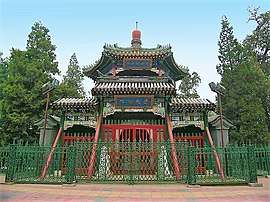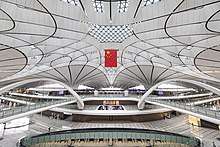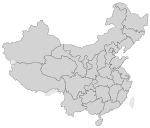Beijing
Beijing (/ˌbeɪˈdʒɪŋ/ BAY-JING[10][11] Mandarin pronunciation: [pèi.tɕíŋ] (![]()
Beijing 北京市 Peking | |
|---|---|
Clockwise from top: Beijing CBD skyline, Great Wall of Badaling, Temple of Heaven, Great Hall of the People (left) and National Centre for the Performing Arts (right), Beijing National Stadium, Tiananmen | |
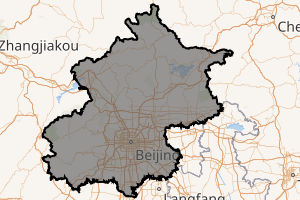
| |
.svg.png) Location of Beijing Municipality within China | |
| Coordinates (Tian'anmen Square national flag): 39°54′24″N 116°23′51″E | |
| Country | People's Republic of China |
| Established | 1045 BC (Zhou Dynasty) |
| Divisions[1] – County-level – Township-level | 16 districts 289 towns and villages |
| Government | |
| • Type | Municipality |
| • Party Secretary | Cai Qi |
| • Mayor | Chen Jining |
| • Congress Chairman | Li Wei |
| • Conference Chairman | Ji Lin |
| Area | |
| • Municipality | 16,410.5 km2 (6,336.1 sq mi) |
| • Urban (2018)[3] | 4,144 km2 (1,600 sq mi) |
| • Rural | 12,266.5 km2 (4,736.1 sq mi) |
| Elevation | 43.5 m (142.7 ft) |
| Population (2018)[4] | |
| • Municipality | 21,542,000 |
| • Density | 1,300/km2 (3,400/sq mi) |
| • Urban (2018)[5] | 21,450,000 |
| • Metro (2017)[6] | 24,000,000 |
| • Ranks in China | Population: 27th; Density: 4th |
| Major ethnic groups | |
| • Han | 95% |
| • Manchu | 2% |
| • Hui | 2% |
| • Mongol | 0.3% |
| • Other | 0.7% |
| Time zone | UTC+8 (CST) |
| Postal codes | 100000–102629 |
| Area code(s) | 10 |
| ISO 3166 code | CN-BJ |
| GDP (nominal)[7] | 2019 |
| - Total | ¥3.5 trillion $513 billion $1.011 trillion (PPP) (12th) |
| – Per capita | ¥162,257 $23,521 $46,433(PPP) (1st) |
| – Growth | |
| HDI (2018) | 0.894[8] (1st) – very high |
| License plate prefixes | 京A, C, E, F, H, J, K, L, M, N, P, Q, Y 京B (taxis) 京G (outside urban area) 京O, D (police and authorities) |
| Abbreviation | BJ / 京 (jīng) |
| City trees | Chinese arborvitae (Platycladus orientalis) |
| Pagoda tree (Sophora japonica) | |
| City flowers | China rose (Rosa chinensis) |
| Chrysanthemum (Chrysanthemum morifolium) | |
| Website | Beijing Official Website International – eBeijing.gov.cn (in English) 首都之窗-北京市政务门户网站 (in Chinese) |
| Beijing | |||||||||||||||||||||||||||||||||||||||||
|---|---|---|---|---|---|---|---|---|---|---|---|---|---|---|---|---|---|---|---|---|---|---|---|---|---|---|---|---|---|---|---|---|---|---|---|---|---|---|---|---|---|
 "Beijing" in regular Chinese characters | |||||||||||||||||||||||||||||||||||||||||
| Chinese | 北京 | ||||||||||||||||||||||||||||||||||||||||
| Hanyu Pinyin | |||||||||||||||||||||||||||||||||||||||||
| Postal | Peking[9] Peiping (1368–1403; 1928–1937; 1945–1949) | ||||||||||||||||||||||||||||||||||||||||
| Literal meaning | "Northern Capital" | ||||||||||||||||||||||||||||||||||||||||
| |||||||||||||||||||||||||||||||||||||||||
Combining both modern and traditional architecture, Beijing is one of the oldest cities in the world, with a rich history dating back three millennia. As the last of the Four Great Ancient Capitals of China, Beijing has been the political center of the country for most of the past eight centuries,[19] and was the largest city in the world by population for much of the second millennium AD.[20] Encyclopædia Britannica notes that "few cities in the world have served for so long as the political headquarters and cultural center of an area as immense as China."[21] With mountains surrounding the inland city on three sides, in addition to the old inner and outer city walls, Beijing was strategically poised and developed to be the residence of the emperor and thus was the perfect location for the imperial capital. The city is renowned for its opulent palaces, temples, parks, gardens, tombs, walls and gates.[22] It has seven UNESCO World Heritage Sites—the Forbidden City, Temple of Heaven, Summer Palace, Ming Tombs, Zhoukoudian, and parts of the Great Wall and the Grand Canal—all of which are tourist locations.[23] Siheyuans, the city's traditional housing style, and hutongs, the narrow alleys between siheyuans, are major tourist attractions and are common in urban Beijing.
Many of Beijing's 91 universities[24] consistently rank among the best in China, such as the Peking University and Tsinghua University. Beijing CBD is a center for Beijing's economic expansion, with the ongoing or recently completed construction of multiple skyscrapers. Beijing's Zhongguancun area is known as China's Silicon Valley and is a center of scientific and technological innovation as well as entrepreneurship.
Etymology
Over the past 3,000 years, the city of Beijing has had numerous other names. The name Beijing, which means "Northern Capital" (from the Chinese characters 北 for north and 京 for capital), was applied to the city in 1403 during the Ming dynasty to distinguish the city from Nanjing (the "Southern Capital").[25] The English spelling Beijing is based on the pinyin romanization (adopted in the 1980s) of the two characters as they are pronounced in Standard Mandarin. An older English spelling, Peking is the postal romanization of the same two characters as they are pronounced in Chinese dialects spoken in the southern port towns first visited by European traders and missionaries.[26] Those dialects preserve the Middle Chinese pronunciation of 京 as kjaeng,[27] prior to a phonetic shift in the northern dialects to the modern pronunciation.[28] Although Peking is no longer the common name for the city, some of the city's older locations and facilities, such as Beijing Capital International Airport, with IATA Code PEK, and Peking University, still use the former romanization.
The single Chinese character abbreviation for Beijing is 京, which appears on automobile license plates in the city. The official Latin alphabet abbreviation for Beijing is "BJ".[29]
History
Early history
The earliest traces of human habitation in the Beijing municipality were found in the caves of Dragon Bone Hill near the village of Zhoukoudian in Fangshan District, where Peking Man lived. Homo erectus fossils from the caves date to 230,000 to 250,000 years ago. Paleolithic Homo sapiens also lived there more recently, about 27,000 years ago.[30] Archaeologists have found neolithic settlements throughout the municipality, including in Wangfujing, located in central Beijing.
The first walled city in Beijing was Jicheng, the capital city of the state of Ji and was built in 1045 BC. Within modern Beijing, Jicheng was located around the present Guang'anmen area in the south of Xicheng District.[31] This settlement was later conquered by the state of Yan and made its capital.[32]
Early Imperial China
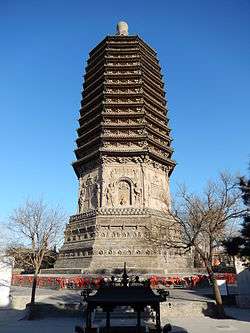
After the First Emperor unified China, Jicheng became a prefectural capital for the region.[1] During the Three Kingdoms period, it was held by Gongsun Zan and Yuan Shao before falling to the Wei Kingdom of Cao Cao. The AD 3rd-century Western Jin demoted the town, placing the prefectural seat in neighboring Zhuozhou.
During the Sixteen Kingdoms period when northern China was conquered and divided by the Wu Hu, Jicheng was briefly the capital of the Xianbei Former Yan Kingdom.[33]
After China was reunified during the Sui dynasty, Jicheng, also known as Zhuojun, became the northern terminus of the Grand Canal. Under the Tang dynasty, Jicheng as Youzhou, served as a military frontier command center. During the An-Shi Rebellion and again amidst the turmoil of the late Tang, local military commanders founded their own short-lived Yan dynasties and called the city Yanjing, or the "Yan Capital." Also in the Tang dynasty, the city's name Jicheng was replaced by Youzhou or Yanjing. In 938, after the fall of the Tang, the Later Jin ceded the entire northern frontier to the Khitan Liao dynasty, which treated the city as Nanjing, or the "Southern Capital", one of four secondary capitals to complement its "Supreme Capital", Shangjing (modern Baarin Left Banner in Inner Mongolia). Some of the oldest surviving structures in Beijing date to the Liao period, including the Tianning Pagoda.
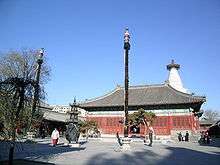
The Liao fell to the Jurchen Jin dynasty in 1122, which gave the city to the Song dynasty and then retook it in 1125 during its conquest of northern China. In 1153, the Jurchen Jin made Beijing their "Central Capital", or Zhongdu.[1] The city was besieged by Genghis Khan's invading Mongolian army in 1213 and razed to the ground two years later.[34] Two generations later, Kublai Khan ordered the construction of Dadu (or Daidu to the Mongols, commonly known as Khanbaliq), a new capital for his Yuan dynasty to the northeast of the Zhongdu ruins. The construction took from 1264 to 1293,[1][34][35] but greatly enhanced the status of a city on the northern fringe of China proper. The city was centered on the Drum Tower slightly to the north of modern Beijing and stretched from the present-day Chang'an Avenue to the northern part of Line 10 subway. Remnants of the Yuan rammed earth wall still stand and are known as the Tucheng.[36]
Ming dynasty
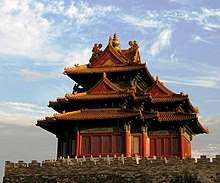
In 1368, soon after declaring the new Hongwu era of the Ming dynasty, the rebel leader Zhu Yuanzhang sent an army to Khanbaliq and conquered it.[37] Since the Yuan continued to occupy Shangdu and Mongolia, however, Dadu was renamed Beiping as used to supply the military garrisons in the area.[38] And under the Hongwu Emperor's feudal policies it was given to Zhu Di, one of his sons, who was created "Prince of Yan".
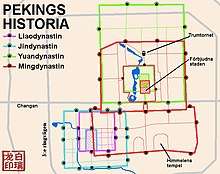
The early death of Zhu Yuanzhang's heir led to a succession struggle on his death, one that ended with the victory of Zhu Di and the declaration of the new Yongle era. Since his harsh treatment of the Ming capital Yingtian (modern Nanjing) alienated many there, he established his fief as a new co-capital. The city of Beiping became Beijing (northern capital) or Shuntian[39] in 1403.[25] The construction of the new imperial residence, the Forbidden City, took from 1406 to 1420;[34] this period was also responsible for several other of the modern city's major attractions, such as the Temple of Heaven[40] and Tian'anmen. On 28 October 1420, the city was officially designated the capital of the Ming dynasty in the same year that the Forbidden City was completed.[41] Beijing became the empire's primary capital and Yingtian, also called Nanjing (southern capital), became the co-capital. (A 1425 order by Zhu Di's son, the Hongxi Emperor, to return the primary capital to Nanjing was never carried out: he died, probably of a heart attack, the next month. He was buried, like almost every Ming emperor to follow him, in an elaborate necropolis to Beijing's north.)
By the 15th century, Beijing had essentially taken its current shape. The Ming city wall continued to serve until modern times, when it was pulled down and the 2nd Ring Road was built in its place.[42] It is generally believed that Beijing was the largest city in the world for most of the 15th, 16th, 17th, and 18th centuries.[43] The first known church was constructed by Catholics in 1652 at the former site of Matteo Ricci's chapel; the modern Nantang Cathedral was later built upon the same site.[44]
The capture of Beijing by Li Zicheng's peasant army in 1644 ended the dynasty, but he and his Shun court abandoned the city without a fight when the Manchu army of Prince Dorgon arrived 40 days later.
Qing dynasty
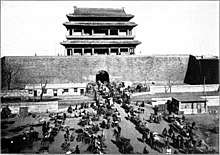
Dorgon established the Qing dynasty as a direct successor of the Ming (delegitimising Li Zicheng and his followers)[45] and Beijing became China's sole capital.[46] The Qing emperors made some modifications to the Imperial residence but, in large part, the Ming buildings and the general layout remained unchanged. Facilities for Manchu worship were introduced, but the Qing also continued the traditional state rituals. Signage was bilingual or Chinese. This early Qing Beijing later formed the setting for the Chinese novel Dream of the Red Chamber. Northwest of the city, Qing emperors built several large palatial gardens including the Old Summer Palace and the Summer Palace.
During the Second Opium War, Anglo-French forces captured the outskirts of the city, looting and burning the Old Summer Palace in 1860. Under the Convention of Peking ending that war, Western powers for the first time secured the right to establish permanent diplomatic presences within the city. From 14–15 August 1900 the Battle of Peking was fought. This battle was part of the Boxer Rebellion. The attempt by the Boxers to eradicate this presence, as well as Chinese Christian converts, led to Beijing's reoccupation by eight foreign powers.[47] During the fighting, several important structures were destroyed, including the Hanlin Academy and the (new) Summer Palace. A peace agreement was concluded between the Eight-Nation Alliance and representatives of the Chinese government Li Hung-chang and Prince Ching on 7 September 1901. The treaty required China to pay an indemnity of $335 million (over $4 billion in current dollars) plus interest over a period of 39 years. Also required was the execution or exile of government supporters of the Boxers and the destruction of Chinese forts and other defenses in much of northern China. Ten days after the treaty was signed the foreign armies left Peking, although legation guards would remain there until World War II.[48]
With the treaty signed the Empress Dowager Cixi returned to Peking from her "tour of inspection" on 7 January 1902 and the rule of the Qing dynasty over China was restored, albeit much weakened by the defeat it had suffered in the Boxer Rebellion and by the indemnity and stipulations of the peace treaty.[49] The Dowager died in 1908 and the dynasty imploded in 1911.
Republic of China
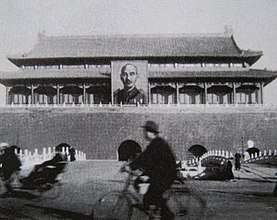
The fomenters of the Xinhai Revolution of 1911 sought to replace Qing rule with a republic and leaders like Sun Yat-sen originally intended to return the capital to Nanjing. After the Qing general Yuan Shikai forced the abdication of the last Qing emperor and ensured the success of the revolution, the revolutionaries accepted him as president of the new Republic of China. Yuan maintained his capital at Beijing and quickly consolidated power, declaring himself emperor in 1915. His death less than a year later[50] left China under the control of the warlords commanding the regional armies. Following the success of the Kuomintang's Northern Expedition, the capital was formally moved to Nanjing in 1928. On 28 June the same year, Beijing's name was returned to Beiping (written at the time as "Peiping").[15][51]
On 7 July 1937, the 29th Army and the Japanese army in China exchanged fire at the Marco Polo Bridge near the Wanping Fortress southwest of the city. The Marco Polo Bridge Incident triggered the Second Sino-Japanese War, World War II as it is known in China. During the war,[15] Beijing fell to Japan on 29 July 1937[52] and was made the seat of the Provisional Government of the Republic of China, a puppet state that ruled the ethnic-Chinese portions of Japanese-occupied northern China.[53] This government was later merged into the larger Wang Jingwei government based in Nanjing.[54]
People's Republic of China
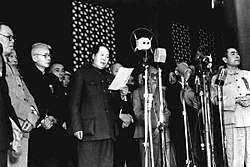
In the final phases of the Chinese Civil War, the People's Liberation Army seized control of the city peacefully on 31 January 1949 in the course of the Pingjin Campaign. On 1 October that year, Mao Zedong announced the creation of the People's Republic of China from atop Tian'anmen. He restored the name of the city, as the new capital, to Beijing,[55] a decision that had been reached by the Chinese People's Political Consultative Conference just a few days earlier.
In the 1950s, the city began to expand beyond the old walled city and its surrounding neighborhoods, with heavy industries in the west and residential neighborhoods in the north. Many areas of the Beijing city wall were torn down in the 1960s to make way for the construction of the Beijing Subway and the 2nd Ring Road.
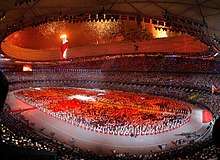
During the Cultural Revolution from 1966 to 1976, the Red Guard movement began in Beijing and the city's government fell victim to one of the first purges. By the autumn of 1966, all city schools were shut down and over a million Red Guards from across the country gathered in Beijing for eight rallies in Tian'anmen Square with Mao.[56] In April 1976, a large public gathering of Beijing residents against the Gang of Four and the Cultural Revolution in Tiananmen Square was forcefully suppressed. In October 1976, the Gang was arrested in Zhongnanhai and the Cultural Revolution came to an end. In December 1978, the Third Plenum of the 11th Party Congress in Beijing under the leadership of Deng Xiaoping reversed the verdicts against victims of the Cultural Revolution and instituted the "policy of reform and opening up."
Since the early 1980s, the urban area of Beijing has expanded greatly with the completion of the 2nd Ring Road in 1981 and the subsequent addition of the 3rd, 4th, 5th and 6th Ring Roads.[57][58] According to one 2005 newspaper report, the size of newly developed Beijing was one-and-a-half times larger than before.[59] Wangfujing and Xidan have developed into flourishing shopping districts,[60] while Zhongguancun has become a major center of electronics in China.[61] In recent years, the expansion of Beijing has also brought to the forefront some problems of urbanization, such as heavy traffic, poor air quality, the loss of historic neighborhoods, and a significant influx of migrant workers from less-developed rural areas of the country.[62] Beijing has also been the location of many significant events in recent Chinese history, principally the Tiananmen Square protests of 1989.[63] The city has also hosted major international events, including the 2008 Summer Olympics and the 2015 World Championships in Athletics, and was chosen to host the 2022 Winter Olympics, making it the first city to ever host both Winter and Summer Olympics.[64]
Geography
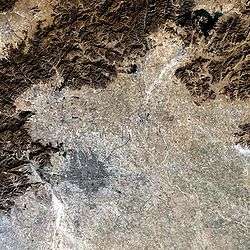
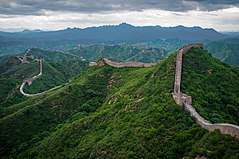
Beijing is situated at the northern tip of the roughly triangular North China Plain, which opens to the south and east of the city. Mountains to the north, northwest and west shield the city and northern China's agricultural heartland from the encroaching desert steppes. The northwestern part of the municipality, especially Yanqing County and Huairou District, are dominated by the Jundu Mountains, while the western part is framed by Xishan or the Western Hills. The Great Wall of China across the northern part of Beijing Municipality was built on the rugged topography to defend against nomadic incursions from the steppes. Mount Dongling, in the Western Hills and on the border with Hebei, is the municipality's highest point, with an altitude of 2,303 metres (7,556 ft).
Major rivers flowing through the municipality, including the Chaobai, Yongding, Juma, are all tributaries in the Hai River system, and flow in a southeasterly direction. The Miyun Reservoir, on the upper reaches of the Chaobai River, is the largest reservoir within the municipality. Beijing is also the northern terminus of the Grand Canal to Hangzhou, which was built over 1,400 years ago as a transportation route, and the South–North Water Transfer Project, constructed in the past decade to bring water from the Yangtze River basin.
The urban area of Beijing, on the plains in the south-central of the municipality with elevation of 40 to 60 metres (130–200 feet), occupies a relatively small but expanding portion of the municipality's area. The city spreads out in concentric ring roads. The Second Ring Road traces the old city walls and the Sixth Ring Road connects satellite towns in the surrounding suburbs. Tian'anmen and Tian'anmen Square are at the center of Beijing, directly to the south of the Forbidden City, the former residence of the emperors of China. To the west of Tian'anmen is Zhongnanhai, the residence of China's current leaders. Chang'an Avenue, which cuts between Tiananmen and the Square, forms the city's main east–west axis.
Cityscape
Architecture
Three styles of architecture are predominant in urban Beijing. First, there is the traditional architecture of imperial China, perhaps best exemplified by the massive Tian'anmen (Gate of Heavenly Peace), which remains the People's Republic of China's trademark edifice, the Forbidden City, the Imperial Ancestral Temple and the Temple of Heaven. Next, there is what is sometimes referred to as the "Sino-Sov" style, with structures tending to be boxy and sometimes poorly constructed, which were built between the 1950s and the 1970s.[65] Finally, there are much more modern architectural forms, most noticeably in the area of the Beijing CBD in east Beijing such as the new CCTV Headquarters, in addition to buildings in other locations around the city such as the Beijing National Stadium and National Center for the Performing Arts.
Since 2007, buildings in Beijing have received the CTBUH Skyscraper Award for best overall tall building twice, for the Linked Hybrid building in 2009 and the CCTV Headquarters in 2013. The CTBUH Skyscraper award for best tall overall building is given to only one building around the world every year.
In the early 21st century, Beijing has witnessed tremendous growth of new building constructions, exhibiting various modern styles from international designers, most pronounced in the CBD region. A mixture of both 1950s design and neofuturistic style of architecture can be seen at the 798 Art Zone, which mixes the old with the new. Beijing's current completed tallest building is the 330-meter China World Trade Center Tower III, but will be surpassed by the 528-meter China Zun in 2018 when it is completed. Both buildings are in the Beijing CBD.
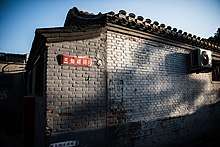
Beijing is famous for its siheyuans, a type of residence where a common courtyard is shared by the surrounding buildings. Among the more grand examples are the Prince Gong Mansion and Residence of Soong Ching-ling. These courtyards are usually connected by alleys called hutongs. The hutongs are generally straight and run east to west so that doorways face north and south for good Feng Shui. They vary in width; some are so narrow only a few pedestrians can pass through at a time. Once ubiquitous in Beijing, siheyuans and hutongs are rapidly disappearing,[66] as entire city blocks of hutongs are replaced by high-rise buildings.[67] Residents of the hutongs are entitled to live in the new buildings in apartments of at least the same size as their former residences. Many complain, however, that the traditional sense of community and street life of the hutongs cannot be replaced,[68] and these properties are often government owned.[69]
Climate
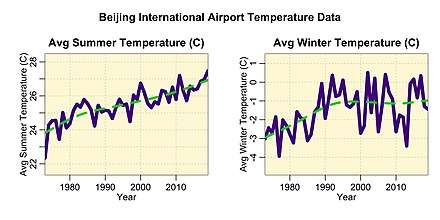
Beijing has a monsoon-influenced humid continental climate (Köppen: Dwa), characterized by very hot, humid summers due to the East Asian monsoon, and brief but cold, dry winters that reflect the influence of the vast Siberian anticyclone.[70] Spring can bear witness to sandstorms blowing in from the Gobi Desert across the Mongolian steppe, accompanied by rapidly warming, but generally dry, conditions. Autumn, similar to spring, is a season of transition and minimal precipitation. The monthly daily average temperature in January is −2.9 °C (26.8 °F), while in July it is 26.9 °C (80.4 °F). Precipitation averages around 570 mm (22 in) annually, with close to three-fourths of that total falling from June to August. With monthly percent possible sunshine ranging from 47% in July to 65% in January and February, the city receives 2,671 hours of bright sunshine annually. Extremes since 1951 have ranged from −27.4 °C (−17.3 °F) on 22 February 1966 to 41.9 °C (107.4 °F) on 24 July 1999 (unofficial record of 42.6 °C (108.7 °F) was set on 15 June 1942).[71][72]
| Climate data for Beijing (normals 1986–2015, extremes 1951–present) | |||||||||||||
|---|---|---|---|---|---|---|---|---|---|---|---|---|---|
| Month | Jan | Feb | Mar | Apr | May | Jun | Jul | Aug | Sep | Oct | Nov | Dec | Year |
| Record high °C (°F) | 14.3 (57.7) |
19.8 (67.6) |
29.5 (85.1) |
33.5 (92.3) |
41.1 (106.0) |
40.6 (105.1) |
41.9 (107.4) |
38.3 (100.9) |
35.0 (95.0) |
31.0 (87.8) |
23.3 (73.9) |
19.5 (67.1) |
41.9 (107.4) |
| Average high °C (°F) | 2.1 (35.8) |
5.8 (42.4) |
12.6 (54.7) |
20.7 (69.3) |
26.9 (80.4) |
30.5 (86.9) |
31.5 (88.7) |
30.5 (86.9) |
26.2 (79.2) |
19.4 (66.9) |
10.3 (50.5) |
3.8 (38.8) |
18.4 (65.0) |
| Daily mean °C (°F) | −2.9 (26.8) |
0.4 (32.7) |
7.0 (44.6) |
14.9 (58.8) |
21.0 (69.8) |
25.0 (77.0) |
26.9 (80.4) |
25.8 (78.4) |
20.8 (69.4) |
13.8 (56.8) |
5.1 (41.2) |
−0.9 (30.4) |
13.1 (55.5) |
| Average low °C (°F) | −7.1 (19.2) |
−4.3 (24.3) |
1.6 (34.9) |
8.9 (48.0) |
14.9 (58.8) |
19.8 (67.6) |
22.7 (72.9) |
21.7 (71.1) |
16.0 (60.8) |
8.8 (47.8) |
0.6 (33.1) |
−4.9 (23.2) |
8.2 (46.8) |
| Record low °C (°F) | −22.8 (−9.0) |
−27.4 (−17.3) |
−15 (5) |
−3.2 (26.2) |
2.5 (36.5) |
9.8 (49.6) |
15.3 (59.5) |
11.4 (52.5) |
3.7 (38.7) |
−3.5 (25.7) |
−12.3 (9.9) |
−18.3 (−0.9) |
−27.4 (−17.3) |
| Average precipitation mm (inches) | 2.7 (0.11) |
5.0 (0.20) |
10.2 (0.40) |
23.1 (0.91) |
39.0 (1.54) |
76.7 (3.02) |
168.8 (6.65) |
120.2 (4.73) |
57.4 (2.26) |
24.1 (0.95) |
13.1 (0.52) |
2.4 (0.09) |
542.7 (21.38) |
| Average precipitation days (≥ 0.1 mm) | 1.8 | 2.3 | 3.3 | 4.7 | 6.1 | 9.9 | 12.8 | 10.9 | 7.6 | 4.8 | 2.9 | 2.0 | 69.1 |
| Average relative humidity (%) | 44 | 43 | 41 | 43 | 49 | 59 | 70 | 72 | 65 | 58 | 54 | 47 | 54 |
| Mean monthly sunshine hours | 186.2 | 188.1 | 227.5 | 242.8 | 267.6 | 225.6 | 194.5 | 208.2 | 207.5 | 205.2 | 174.5 | 172.3 | 2,500 |
| Percent possible sunshine | 65 | 65 | 63 | 64 | 64 | 59 | 47 | 52 | 63 | 64 | 62 | 62 | 60 |
| Average ultraviolet index | 2 | 3 | 4 | 6 | 8 | 9 | 9 | 8 | 6 | 4 | 2 | 1 | 5 |
| Source: China Meteorological Administration [73], China Meteorological Data Sharing Service System[74], all-time record high[72], May record high[75] and Weather Atlas[76] | |||||||||||||
Environmental issues
Beijing has a long history of environmental problems.[77] Between 2000 and 2009 Beijing's urban extent quadrupled, which not only strongly increased the extent of anthropogenic emissions, but also changed the meteorological situation fundamentally, even if emissions of human society are not included. For example, surface albedo, wind speed and humidity near the surface were decreased, whereas ground and near-surface air temperatures, vertical air dilution and ozone levels were increased.[78] Because of the combined factors of urbanization and pollution caused by burning of fossil fuel, Beijing is often affected by serious environmental problems, which lead to health issues of many inhabitants. In 2013 heavy smog struck Beijing and most parts of northern China, impacting a total of 600 million people. After this "pollution shock" air pollution became an important economic and social concern in China. After that the government of Beijing announced measures to reduce air pollution, for example by lowering the share of coal from 24% in 2012 to 10% in 2017, while the national government ordered heavily polluting vehicles to be removed from 2015 to 2017 and increased its efforts to transition the energy system to clean sources.[79]
Air quality
Joint research between American and Chinese researchers in 2006 concluded that much of the city's pollution comes from surrounding cities and provinces. On average 35–60% of the ozone can be traced to sources outside the city. Shandong Province and Tianjin Municipality have a "significant influence on Beijing's air quality",[80] partly due to the prevailing south/southeasterly flow during the summer and the mountains to the north and northwest.
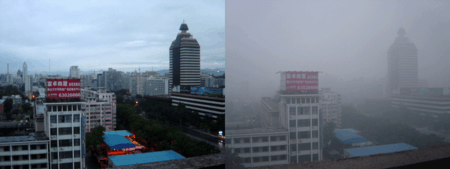
In preparation for the 2008 Summer Olympics and to fulfill promises to clean up the city's air, nearly US$17 billion was spent.[81] Beijing implemented a number of air improvement schemes for the duration of the Games, including halting work at all construction sites, closing many factories in Beijing permanently, temporarily shutting industry in neighboring regions, closing some gas stations,[82] and cutting motor traffic by half by limiting drivers to odd or even days (based on their license plate numbers),[83] reducing bus and subway fares, opening new subway lines, and banning high-emission vehicles.[84][85] The city further assembled 3,800 natural gas-powered buses, one of the largest fleets in the world.[81] Beijing became the first city in China to require the Chinese equivalent to the Euro 4 emission standard.[86]
Coal burning accounts for about 40% of the PM 2.5 in Beijing and is also the chief source of nitrogen and sulphur dioxide.[87] Since 2012, the city has been converting coal-fired power stations to burn natural gas[88] and aims to cap annual coal consumption at 20 million tons. In 2011, the city burned 26.3 million tons of coal, 73% of which for heating and power generation and the remainder for industry.[88] Much of the city's air pollutants are emitted by neighboring regions.[87] Coal consumption in neighboring Tianjin is expected to increase from 48 to 63 million tons from 2011 to 2015.[89] Hebei Province burned over 300 million tons of coal in 2011, more than all of Germany, of which only 30% were used for power generation and a considerable portion for steel and cement making.[90] Power plants in the coal-mining regions of Shanxi, Inner Mongolia and Shaanxi, where coal consumption has tripled since 2000, and Shandong also contribute to air pollution in Beijing.[87] Shandong, Shanxi, Hebei and Inner Mongolia, respectively rank from first to fourth, among Chinese provinces by coal consumption.[89] There were four major coal-fired power plants in the city to provide electricity as well as heating during the winter. The first one (Gaojing Thermal Power Plant) was shut down in 2014.[91][92] Another two were shut in March 2015. The last one (Huaneng Thermal Power Plant) would be shut in 2016.[91] Between 2013 and 2017, the city planned to reduce 13 million tons of coal consumption and cap coal consumption to 15 million tons in 2015.[91]
The government sometimes uses cloud-seeding measures to increase the likelihood of rain showers in the region to clear the air prior to large events, such as prior to the 60th anniversary parade in 2009[93] as well as to combat drought conditions in the area. More recently, however, the government has increased its usage of such measures as closing factories temporarily and implementing greater restrictions for cars on the road, as in the case of "APEC blue" and "parade blue," short periods during and immediately preceding the APEC China 2014 and the 2015 China Victory Day Parade, respectively.[94] During and prior to these events, Beijing's air quality improved dramatically, only to fall back to unhealthy levels shortly after.
Beijing air quality is often poor, especially in winter. In mid-January 2013, Beijing's air quality was measured on top of the city's US embassy at a PM2.5 density of 755 micrograms per cubic meter, which is more than 75 times the safe level established by the WHO, and went off the US Environmental Protection Agency's air quality index. It was widely reported, originally through a Twitter account, that the category was "crazy bad". This was later changed to "beyond index".[95]
On 8 and 9 December 2015 Beijing had its first smog alert which shut down a majority of the industry and other commercial businesses in the city.[96] Later in the month another smog "red alert" was issued.[97]
According to Beijing's environmental protection bureau's announcement in November 2016, starting from 2017 highly polluting old cars will be banned from being driven whenever Smog "red alerts" are issued in the city or neighboring regions.[98]
In recent years, there has been measurable reductions in pollutants after the "war on pollution" was declared in 2014, with Beijing seeing a 35% reduction in fine particulates in 2017.[99]
Readings
Due to Beijing's high level of air pollution, there are various readings by different sources on the subject. Daily pollution readings at 27 monitoring stations around the city are reported on the website of the Beijing Environmental Protection Bureau (BJEPB).[100] The American Embassy of Beijing also reports hourly fine particulate (PM2.5) and ozone levels on Twitter.[101] Since the BJEPB and US Embassy measure different pollutants according to different criteria, the pollution levels and the impact to human health reported by the BJEPB are often lower than that reported by the US Embassy.[101]
The smog is causing harm and danger to the population. The air pollution does directly result in significant impact on the mobility rate of cardiovascular disease and respiratory disease in Beijing.[102] Exposure to large concentrations of polluted air can cause respiratory and cardiovascular problems, emergency room visits, and even death.[103]

Dust storms
Dust from the erosion of deserts in northern and northwestern China results in seasonal dust storms that plague the city; the Beijing Weather Modification Office sometimes artificially induces rainfall to fight such storms and mitigate their effects.[104] In the first four months of 2006 alone, there were no fewer than eight such storms.[105] In April 2002, one dust storm alone dumped nearly 50,000 tons of dust onto the city before moving on to Japan and Korea.[106]
Government
Municipal government is regulated by the local Communist Party of China (CPC), led by the Beijing CPC Secretary (Chinese: 北京市委书记). The local CPC issues administrative orders, collects taxes, manages the economy, and directs a standing committee of the Municipal People's Congress in making policy decisions and overseeing the local government.
Government officials include the mayor (Chinese: 市长) and vice-mayor. Numerous bureaus focus on law, public security, and other affairs. Additionally, as the capital of China, Beijing houses all of the important national governmental and political institutions, including the National People's Congress.[107]
Administrative divisions
Beijing Municipality currently comprises 16 administrative county-level subdivisions including 16 urban, suburban, and rural districts. On 1 July 2010, Chongwen and Xuanwu were merged into Dongcheng and Xicheng, respectively. On 13 November 2015 Miyun and Yanqing were upgraded to districts.
| Administrative divisions of Beijing | ||||||||||||||
|---|---|---|---|---|---|---|---|---|---|---|---|---|---|---|
| Division code[108] | Division | Area in km2[109] | Total population 2010[110] | Urban area population 2010[111] |
Seat | Postal code | Subdivisions[112] | |||||||
| Subdistricts | Towns | Townships [n 1] |
Residential communities | Villages | ||||||||||
| 110000 | Beijing | 16406.16 | 19,612,368 | 16,858,692 | Dongcheng / Tongzhou | 100000 | 149 | 143 | 38 | 2538 | 3857 | |||
| 110101 | Dongcheng | 41.82 | 919,253 | Jingshan Subdistrict | 100000 | 17 | 216 | |||||||
| 110102 | Xicheng | 50.33 | 1,243,315 | Jinrong Street Subdistrict | 100000 | 15 | 259 | |||||||
| 110105 | Chaoyang | 454.78 | 3,545,137 | 3,532,257 | Chaowai Subdistrict | 100000 | 24 | 19 | 358 | 5 | ||||
| 110106 | Fengtai | 305.53 | 2,112,162 | 2,098,632 | Fengtai Subdistrict | 100000 | 16 | 2 | 3 | 254 | 73 | |||
| 110107 | Shijingshan | 84.38 | 616,083 | Lugu Subdistrict | 100000 | 9 | 130 | |||||||
| 110108 | Haidian | 430.77 | 3,280,670 | 3,208,563 | Haidian Subdistrict | 100000 | 22 | 7 | 603 | 84 | ||||
| 110109 | Mentougou | 1447.85 | 290,476 | 248,547 | Dayu Subdistrict | 102300 | 4 | 9 | 124 | 179 | ||||
| 110111 | Fangshan | 1994.73 | 944,832 | 635,282 | Gongchen Subdistrict | 102400 | 8 | 14 | 6 | 108 | 462 | |||
| 110112 | Tongzhou | 905.79 | 1,184,256 | 724,228 | Beiyuan Subdistrict | 101100 | 6 | 10 | 1 | 40 | 480 | |||
| 110113 | Shunyi | 1019.51 | 876,620 | 471,459 | Shengli Subdistrict | 101300 | 6 | 19 | 61 | 449 | ||||
| 110114 | Changping | 1342.47 | 1,660,501 | 1,310,617 | Chengbei Subdistrict | 102200 | 8 | 14 | 180 | 303 | ||||
| 110115 | Daxing | 1036.34 | 1,365,112 | 965,683 | Xingfeng Subdistrict | 102600 | 5 | 14 | 64 | 547 | ||||
| 110116 | Huairou | 2122.82 | 372,887 | 253,088 | Longshan Subdistrict | 101400 | 2 | 12 | 2 | 27 | 286 | |||
| 110117 | Pinggu | 948.24 | 415,958 | 219,850 | Binhe Subdistrict | 101200 | 2 | 14 | 2 | 23 | 275 | |||
| 110118 | Miyun | 2225.92 | 467,680 | 257,449 | Gulou Subdistrict | 101500 | 2 | 17 | 1 | 57 | 338 | |||
| 110119 | Yanqing | 1994.89 | 317,426 | 154,386 | Rulin Subdistrict | 102100 | 3 | 11 | 4 | 34 | 376 | |||
| Divisions in Chinese | ||||
|---|---|---|---|---|
| English | Chinese | Pinyin | ||
| Beijing Municipality | 北京市 | Běijīng Shì | ||
| Dongcheng District | 东城区 | Dōngchéng Qū | ||
| Xicheng District | 西城区 | Xīchéng Qū | ||
| Chaoyang District | 朝阳区 | Cháoyáng Qū | ||
| Fengtai District | 丰台区 | Fēngtái Qū | ||
| Shijingshan District | 石景山区 | Shíjǐngshān Qū | ||
| Haidian District | 海淀区 | Hǎidiàn Qū | ||
| Mentougou District | 门头沟区 | Méntóugōu Qū | ||
| Fangshan District | 房山区 | Fángshān Qū | ||
| Tongzhou District | 通州区 | Tōngzhōu Qū | ||
| Shunyi District | 顺义区 | Shùnyì Qū | ||
| Changping District | 昌平区 | Chāngpíng Qū | ||
| Daxing District | 大兴区 | Dàxīng Qū | ||
| Huairou District | 怀柔区 | Huáiróu Qū | ||
| Pinggu District | 平谷区 | Pínggǔ Qū | ||
| Miyun District | 密云区 | Mìyún Qū | ||
| Yanqing District | 延庆区 | Yánqìng Qū | ||
- Including Ethnic townships & other township related subdivisions.
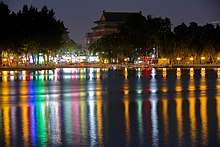
Towns
Beijing's 16 county-level divisions (districts) are further subdivided into 273 lower third-level administrative units at the township level: 119 towns, 24 townships, 5 ethnic townships and 125 subdistricts. Towns within Beijing Municipality but outside the urban area include (but are not limited to):
- Changping 昌平
- Huairou 怀柔
- Miyun 密云
- Liangxiang 良乡
- Liulimiao 琉璃庙
- Tongzhou 通州
- Yizhuang 亦庄
- Tiantongyuan 天通苑
- Beiyuan 北苑
- Xiaotangshan 小汤山
Several place names in Beijing end with mén (门), meaning "gate", as they were the locations of gates in the former Beijing city wall. Other place names end in cūn (村), meaning "village", as they were originally villages outside the city wall.
Judiciary and procuracy
The judicial system in Beijing consists of the Supreme People's Court, the highest court in the country, the Beijing Municipal High People's Court, the high people's court of the municipality, three intermediate people's courts, one intermediate railway transport court, 14 basic people's court (one for each of the municipality's districts and counties), and one basic railway transport court. The Beijing No. 1 Intermediate People's Court in Shijingshan oversees the basic courts of Haidian, Shijingshan, Mentougou, Changping and Yanqing.[113] The Beijing No. 2 Intermediate People's Court in Fengtai oversees the basic courts of Dongcheng, Xicheng, Fengtai, Fangshan and Daxing.[113] The Beijing No. 3 Intermediate People's Court in Laiguangying, is the newest of the three intermediate people's courts and opened on 21 August 2013.[113] It oversees the district courts of Chaoyang, Tongzhou, Shunyi, Huairou, Pinggu and Miyun.[113][114] Each court in Beijing has a corresponding people's procuratorate.
Diplomatic missions
About 163 countries have embassies in Beijing, which are concentrated in Jianguomenwai, Sanlitun and Liangmaqiao in Chaoyang District.
Beijing is home to the headquarters of the Shanghai Cooperation Organisation (SCO), making it an important city for international diplomacy.
Economy
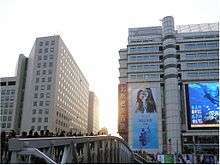
As of 2018, Beijing' Nominal GDP was US$458 billion (CN¥3.0 trilion), about 3.45% of the country's GDP and ranked 12th among province-level administrative units; its Nominal GDP per capita was US$21,261 (CN¥140,748) and ranked the 1st in the country.[115]
Due to the concentration of state owned enterprises in the national capital, Beijing in 2013 had more Fortune Global 500 Company headquarters than any other city in the world.[116] Beijing has also been described as the "billionaire capital of the world".[117][118]
| Historical GDP of Beijing for 1978–present (SNA2008)[115] (purchasing power parity of Chinese Yuan, as Int'l. dollar based on IMF WEO October 2017[119]) | |||||||||
| year | GDP | GDP per capita (GDPpc) based on mid-year population |
Reference index | ||||||
| GDP in millions | real growth (%) |
GDPpc | exchange rate 1 foreign currency to CNY | ||||||
| CNY | USD | PPP (Int'l$.) |
CNY | USD | PPP (Int'l$.) |
USD 1 | Int'l$. 1 (PPP) | ||
| 2016 | 2,566,910 | 386,449 | 733,214 | 6.8 | 118,198 | 17,795 | 33,762 | 6.6423 | 3.5009 |
| 2015 | 2,368,570 | 380,285 | 667,297 | 6.9 | 109,602 | 17,597 | 30,878 | 6.2284 | 3.5495 |
| 2014 | 2,194,410 | 357,233 | 618,074 | 7.4 | 102,870 | 16,746 | 28,974 | 6.1428 | 3.5504 |
| 2013 | 2,033,010 | 328,265 | 568,372 | 7.7 | 97,178 | 15,691 | 27,168 | 6.1932 | 3.5769 |
| 2012 | 1,835,010 | 290,695 | 516,788 | 8.0 | 89,778 | 14,222 | 25,284 | 6.3125 | 3.5508 |
| 2011 | 1,662,790 | 257,446 | 474,337 | 8.1 | 83,547 | 12,935 | 23,833 | 6.4588 | 3.5055 |
| 2010 | 1,444,160 | 213,333 | 436,223 | 10.4 | 75,572 | 11,164 | 22,827 | 6.7695 | 3.3106 |
| 2009 | 1,241,900 | 181,804 | 393,317 | 10.0 | 68,405 | 10,014 | 21,664 | 6.8310 | 3.1575 |
| 2008 | 1,139,200 | 164,029 | 358,600 | 9.0 | 66,098 | 9,517 | 20,807 | 6.9451 | 3.1768 |
| 2007 | 1,007,190 | 132,455 | 334,071 | 14.4 | 61,470 | 8,084 | 20,389 | 7.6040 | 3.0149 |
| 2006 | 831,260 | 104,275 | 288,863 | 12.8 | 52,963 | 6,644 | 18,405 | 7.9718 | 2.8777 |
| 2005 | 714,140 | 87,178 | 249,787 | 12.3 | 47,127 | 5,753 | 16,484 | 8.1917 | 2.8590 |
| 2000 | 321,280 | 38,809 | 118,148 | 12.0 | 24,517 | 2,962 | 9,016 | 8.2784 | 2.7193 |
| 1995 | 150,770 | 18,054 | 55,239 | 12.0 | 12,690 | 1,520 | 4,649 | 8.3510 | 2.7294 |
| 1990 | 50,080 | 10,470 | 29,414 | 5.2 | 4,635 | 969 | 2,722 | 4.7832 | 1.7026 |
| 1985 | 25,710 | 8,755 | 18,342 | 8.7 | 2,643 | 900 | 1,886 | 2.9366 | 1.4017 |
| 1980 | 13,910 | 9,283 | 9,301 | 11.8 | 1,544 | 1,030 | 1,032 | 1.4984 | 1.4955 |
| 1978 | 10,880 | 6,462 | 10.5 | 1,257 | 747 | 1.6836 | |||
Sector composition
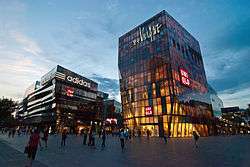
The city has a post-industrial economy that is dominated by the tertiary sector (services), which generated 76.9% of output, followed by the secondary sector (manufacturing, construction) at 22.2% and the primary sector (agriculture, mining) at 0.8%.
The services sector is broadly diversified with professional services, wholesale and retail, information technology, commercial real estate, scientific research, and residential real estate each contributing at least 6% to the city's economy in 2013.[120]
The single largest sub-sector remains industry, whose share of overall output has shrunk to 18.1% in 2013.[120] The mix of industrial output has changed significantly since 2010 when the city announced that 140 highly-polluting, energy and water resource intensive enterprises would be relocated from the city in five years.[121] The relocation of Capital Steel to neighboring Hebei province had begun in 2005.[122][123] In 2013, output of automobiles, aerospace products, semiconductors, pharmaceuticals, and food processing all increased.[120]
In the farmland around Beijing, vegetables and fruits have displaced grain as the primary crops under cultivation.[120] In 2013, the tonnage of vegetable, edible fungus and fruit harvested was over three times that of grain.[120] In 2013, overall acreage under cultivation shrank along with most categories of produce as more land was reforested for environmental reasons.[120]
Economic zones
.jpg)
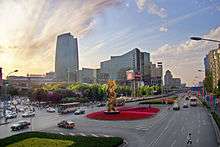
In 2006, the city government identified six high-end economic output zones around Beijing as the primary engines for local economic growth. In 2012, the six zones produced 43.3% of the city's GDP, up from 36.5% in 2007.[124][125] The six zones are:
- Zhongguancun, China's silicon village in Haidian District northwest of the city, is home to both established and start-up tech companies. As of the second quarter of 2014, of the 9,895 companies registered in one of the six zones, 6,150 were based in Zhongguancun.[126]
- Beijing Financial Street, in Xicheng District on the west side of the city between Fuxingmen and Fuchengmen, is lined with headquarters of large state banks and insurance companies. The country's financial regulatory agencies including the central bank, bank regulator, securities regulator, and foreign exchange authority are located in the neighborhood.
- Beijing Central Business District (CBD), is actually located to the east of downtown, near the embassies along the eastern Third Ring Road between Jianguomenwai and Chaoyangmenwai. The CBD is home to most of the city's skyscraper office buildings. Most of the city's foreign companies and professional service firms are based in the CBD.
- Beijing Economic and Technological Development Area, better known as Yizhuang, is an industrial park the straddles the southern Fifth Ring Road in Daxing District. It has attracted pharmaceutical, information technology, and materials engineering companies.[127]
- Beijing Airport Economic Zone was created in 1993 and surrounds the Beijing Capital International Airport in Shunyi District northeast of the city. In addition to logistics, airline services, and trading firms, this zone is also home to Beijing's automobile assembly plants.
- Beijing Olympic Center Zone surrounds the Olympic Green due north of downtown and is developing into an entertainment, sports, tourism and business convention center.
Shijingshan, on the western outskirts of the city, is a traditional heavy industrial base for steel-making.[128] Chemical plants are concentrated in the far eastern suburbs.
Less legitimate enterprises also exist. Urban Beijing is known for being a center of infringed goods; anything from the latest designer clothing to DVDs can be found in markets all over the city, often marketed to expatriates and international visitors.[129]
Demographics
| Year | Pop. | ±% p.a. |
|---|---|---|
| 1953 | 2,768,149 | — |
| 1964 | 7,568,495 | +9.57% |
| 1982 | 9,230,687 | +1.11% |
| 1990 | 10,819,407 | +2.00% |
| 2000 | 13,569,194 | +2.29% |
| 2010 | 19,612,368 | +3.75% |
| 2013 | 21,150,000 | +2.55% |
| 2014[130] | 21,516,000 | +1.73% |
| Population size may be affected by changes on administrative divisions. | ||
In 2013, Beijing had a total population of 21.148 million within the municipality, of which 18.251 million resided in urban districts or suburban townships and 2.897 million lived in rural villages.[120] The encompassing metropolitan area was estimated by the OECD (Organisation for Economic Co-operation and Development) to have, as of 2010, a population of 24.9 million.[131][6]
Within China, the city ranked second in urban population after Shanghai and the third in municipal population after Shanghai and Chongqing. Beijing also ranks among the most populous cities in the world, a distinction the city has held for much of the past 800 years, especially during the 15th to early 19th centuries when it was the largest city in the world.
About 13 million of the city's residents in 2013 had local hukou permits, which entitles them to permanent residence in Beijing.[120] The remaining 8 million residents had hukou permits elsewhere and were not eligible to receive some social benefits provided by the Beijing municipal government.[120]
The population increased in 2013 by 455,000 or about 7% from the previous year and continued a decade-long trend of rapid growth.[120] The total population in 2004 was 14.213 million.[132] The population gains are driven largely by migration. The population's rate of natural increase in 2013 was a mere 0.441%, based on a birth rate of 8.93 and a mortality rate of 4.52.[120] The gender balance was 51.6% males and 48.4% females.[120]
Working age people account for nearly 80% of the population. Compared to 2004, residents age 0–14 as a proportion of the population dropped from 9.96% to 9.5% in 2013 and residents over the age of 65 declined from 11.12% to 9.2%.[120][132] From 2000 to 2010, the percentage of city residents with at least some college education nearly doubled from 16.8% to 31.5%.[133] About 22.2% have some high school education and 31% had reached middle school.[133]
According to the 2010 census, nearly 96% of Beijing's population are ethnic Han Chinese.[133] Of the 800,000 ethnic minorities living in the capital, Manchu (336,000), Hui (249,000), Korean (77,000), Mongol (37,000) and Tujia (24,000) constitute the five largest groups.[134] In addition, there were 8,045 Hong Kong residents, 500 Macau residents, and 7,772 Taiwan residents along with 91,128 registered foreigners living in Beijing.[133] A study by the Beijing Academy of Sciences estimates that in 2010 there were on average 200,000 foreigners living in Beijing on any given day including students, business travellers and tourists that are not counted as registered residents.[135]
In 2017 the Chinese government implemented population controls for Beijing and Shanghai to fight what it called the "big city disease" which includes congestion, pollution, and shortages of education and health care services. From this policy, Beijing's population declined by 20,000 from 2016 to 2017.[136] Some low-income people are being forcibly removed from the city as both legal and illegal housing is being demolished in some high-density residential neighborhoods.[136] The population is being redistributed to Jing-Jin-Ji and Xiong'an New Area, the transfer to the latter expected to include 300,000-500,000 people working in government research, universities, and corporate headquarters.[137][138]
Culture
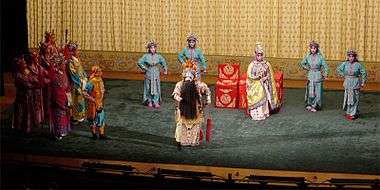
People native to urban Beijing speak the Beijing dialect, which belongs to the Mandarin subdivision of spoken Chinese. This speech is the basis for putonghua, the standard spoken language used in mainland China and Taiwan, and one of the four official languages of Singapore. Rural areas of Beijing Municipality have their own dialects akin to those of Hebei province, which surrounds Beijing Municipality.
Beijing or Peking opera is a traditional form of Chinese theater well known throughout the nation. Commonly lauded as one of the highest achievements of Chinese culture, Beijing opera is performed through a combination of song, spoken dialogue, and codified action sequences involving gestures, movement, fighting and acrobatics. Much of Beijing opera is carried out in an archaic stage dialect quite different from Modern Standard Chinese and from the modern Beijing dialect.[139]
Beijing cuisine is the local style of cooking. Peking Roast Duck is perhaps the best known dish. Fuling Jiabing, a traditional Beijing snack food, is a pancake (bing) resembling a flat disk with a filling made from fu ling, a fungus used in traditional Chinese medicine. Teahouses are common in Beijing.
The cloisonné (or Jingtailan, literally "Blue of Jingtai") metalworking technique and tradition is a Beijing art speciality, and is one of the most revered traditional crafts in China. Cloisonné making requires elaborate and complicated processes which include base-hammering, copper-strip inlay, soldering, enamel-filling, enamel-firing, surface polishing and gilding.[140] Beijing's lacquerware is also well known for its sophisticated and intricate patterns and images carved into its surface, and the various decoration techniques of lacquer include "carved lacquer" and "engraved gold".
Younger residents of Beijing have become more attracted to the nightlife, which has flourished in recent decades, breaking prior cultural traditions that had practically restricted it to the upper class.[141] Today, Houhai, Sanlitun and Wudaokou are Beijing's nightlife hotspots.
In 2012 Beijing was named as City of Design and became part of the UNESCO Creative Cities Network.[142]
Places of interest
...the city remains an epicenter of tradition with the treasures of nearly 2,000 years as the imperial capital still on view—in the famed Forbidden City and in the city's lush pavilions and gardens...
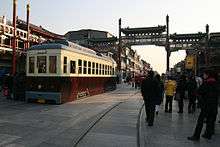
At the historical heart of Beijing lies the Forbidden City, the enormous palace compound that was the home of the emperors of the Ming and Qing dynasties;[144] the Forbidden City hosts the Palace Museum, which contains imperial collections of Chinese art. Surrounding the Forbidden City are several former imperial gardens, parks and scenic areas, notably Beihai, Shichahai, Zhongnanhai, Jingshan and Zhongshan. These places, particularly Beihai Park, are described as masterpieces of Chinese gardening art,[145] and are tourist destinations of historical importance;[146] in the modern era, Zhongnanhai has also been the political heart of various Chinese governments and regimes and is now the headquarters of the Communist Party of China and the State Council. From Tiananmen Square, right across from the Forbidden City, there are several notable sites, such as the Tiananmen, Qianmen, the Great Hall of the People, the National Museum of China, the Monument to the People's Heroes, and the Mausoleum of Mao Zedong. The Summer Palace and the Old Summer Palace both lie at the western part of the city; the former, a UNESCO World Heritage Site,[147] contains a comprehensive collection of imperial gardens and palaces that served as the summer retreats for the Qing imperial family.
_(11524112715).jpg)
Among the best known religious sites in the city is the Temple of Heaven (Tiantan), located in southeastern Beijing, also a UNESCO World Heritage Site,[148] where emperors of the Ming and Qing dynasties made visits for annual ceremonies of prayers to Heaven for good harvest. In the north of the city is the Temple of Earth (Ditan), while the Temple of the Sun (Ritan) and the Temple of the Moon (Yuetan) lie in the eastern and western urban areas respectively. Other well-known temple sites include the Dongyue Temple, Tanzhe Temple, Miaoying Temple, White Cloud Temple, Yonghe Temple, Fayuan Temple, Wanshou Temple and Big Bell Temple. The city also has its own Confucius Temple, and a Guozijian or Imperial Academy. The Cathedral of the Immaculate Conception, built in 1605, is the oldest Catholic church in Beijing. The Niujie Mosque is the oldest mosque in Beijing, with a history stretching back over a thousand years.
.jpg)
Beijing contains several well-preserved pagodas and stone pagodas, such as the towering Pagoda of Tianning Temple, which was built during the Liao dynasty from 1100 to 1120, and the Pagoda of Cishou Temple, which was built in 1576 during the Ming dynasty. Historically noteworthy stone bridges include the 12th-century Lugou Bridge, the 17th-century Baliqiao bridge, and the 18th-century Jade Belt Bridge. The Beijing Ancient Observatory displays pre-telescopic spheres dating back to the Ming and Qing dynasties. The Fragrant Hills (Xiangshan) is a public park that consists of natural landscaped areas as well as traditional and cultural relics. The Beijing Botanical Garden exhibits over 6,000 species of plants, including a variety of trees, bushes and flowers, and an extensive peony garden. The Taoranting, Longtan, Chaoyang, Haidian, Milu Yuan and Zizhu Yuan parks are some of the notable recreational parks in the city. The Beijing Zoo is a center of zoological research that also contains rare animals from various continents, including the Chinese giant panda.
There are 144 museums and galleries (as of June 2008) in the city.[149][150][151] In addition to the Palace Museum in the Forbidden City and the National Museum of China, other major museums include the National Art Museum of China, the Capital Museum, the Beijing Art Museum, the Military Museum of the Chinese People's Revolution, the Geological Museum of China, the Beijing Museum of Natural History and the Paleozoological Museum of China.[151]
Located at the outskirts of urban Beijing, but within its municipality are the Thirteen Tombs of the Ming dynasty, the lavish and elaborate burial sites of thirteen Ming emperors, which have been designated as part of the UNESCO World Heritage Site Imperial Tombs of the Ming and Qing Dynasties.[152] The archaeological Peking Man site at Zhoukoudian is another World Heritage Site within the municipality,[153] containing a wealth of discoveries, among them one of the first specimens of Homo erectus and an assemblage of bones of the gigantic hyena Pachycrocuta brevirostris. There are several sections of the UNESCO World Heritage Site Great Wall of China,[154] most notably Badaling, Jinshanling, Simatai and Mutianyu.
Religion
Religion in Beijing (2010s)
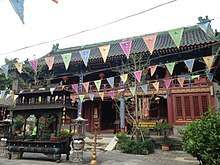
The religious heritage of Beijing is rich and diverse as Chinese folk religion, Taoism, Buddhism, Confucianism, Islam and Christianity all have significant historical presence in the city. As the national capital, the city also hosts the State Administration for Religious Affairs and various state-sponsored institutions of the leading religions.[155] In recent decades, foreign residents have brought other religions to the city.[155] According to Wang Zhiyun of the Chinese Academy of Social Sciences in 2010 there were 2.2 million Buddhists in the city, equal to 11.2% of the total population.[156] According to the Chinese General Social Survey of 2009, Christians constitute 0.78% of the city's population.[157] According to a 2010 survey, Muslims constitute 1.76% of the population of Beijing.[158]
Chinese folk religion and Taoism
Beijing has many temples dedicated to folk religious and communal deities, many of which are being reconstructed or refurbished in the 2000s and 2010s. Yearly sacrifices to the God of Heaven (祭天; jìtiān) at the Temple of Heaven have been resumed by Confucian groups in the 2010s.
There are temples dedicated to the worship of the Goddess (娘娘; Niángniáng) in the city, one of them near the Olympic Village, and they revolve around a major cult center at Mount Miaofeng. There are also many temples consecrated to the Dragon God, to the Medicine Master (药王; Yàowáng), to Divus Guan (Guan Yu), to the Fire God (火神; Huǒshén), to the Wealth God, temples of the City God, and at least one temple consecrated to the Yellow Deity of the Chariot Shaft (轩辕黄帝; Xuānyuán Huángdì) in Pinggu District. Many of these temples are governed by the Beijing Taoist Association, such as the Fire God Temple of the Shicha Lake, while many others are not and are governed by popular committees and locals. A great Temple of Xuanyuan Huangdi will be built in Pinggu (possibly as an expansion of the already existing shrine) within 2020, and the temple will feature a statue of the deity which will be amongst the tallest in the world.[159][160]
The national Chinese Taoist Association and Chinese Taoist College have their headquarters at the White Cloud Temple of Quanzhen Taoism, which was founded in 741 and rebuilt numerous times. The Beijing Dongyue Temple outside Chaoyangmen is the largest temple of Zhengyi Taoism in the city. The local Beijing Taoist Association has its headquarters at the Lüzu Temple near Fuxingmen.[161]
East Asian Buddhism
_-_Pagoda_for_Ordinary_Monks_-_2012.04_-_panoramio.jpg)
11% of the population of Beijing practices East Asian Buddhism. The Buddhist Association of China, the state's supervisory organ overseeing all Buddhist institutions in mainland China, is headquartered in the Guangji Temple, a temple founded over 800 years ago during the Jin dynasty (1115–1234) in what is now Fuchengmennei (阜成门内). The Beijing Buddhist Association along with the Buddhist Choir and Orchestra are based in the Guanghua Temple, which dates to the Yuan dynasty over 700 years ago. The Buddhist Academy of China and its library are housed in the Fayuan Temple near Caishikou. The Fayuan Temple, which dates to the Tang dynasty 1300 years ago, is the oldest temple in urban Beijing. The Tongjiao Temple inside Dongzhimen is the city's only Buddhist nunnery.
The Xihuang Temple originally dates to the Liao dynasty. In 1651, the temple was commissioned by the Qing Emperor Shunzhi to host the visit of the Fifth Dalai Lama to Beijing. Since then, this temple has hosted the 13th Dalai Lama as well as the Sixth, Ninth and Tenth Panchen Lamas. The largest Tibetan Buddhist Temple in Beijing is the Yonghe Temple, which was decreed by the Qing Emperor Qianlong in 1744 to serve as the residence and research facility for his Buddhist preceptor of Rölpé Dorjé the third Changkya (or living Buddha of Inner Mongolia). The Yonghe Temple is so-named because it was the childhood residence of the Yongzheng Emperor, and retains the glazed tiles reserved for imperial palaces.
The Lingguang Temple of Badachu in the Western Hills also dates to the Tang dynasty. The temple's Zhaoxian Pagoda (招仙塔) was first built in 1071 during the Liao dynasty to hold a tooth relic of the Buddha. The pagoda was destroyed during the Boxer Rebellion and the tooth was discovered from its foundation. A new pagoda was built in 1964. The six aforementioned temples: Guangji, Guanghua, Tongjiao, Xihuang, Yonghe and Lingguang have been designated National Key Buddhist Temples in Han Chinese Area.
In addition, other notable temples in Beijing include the Tanzhe Temple (founded in the Jin dynasty (265–420) is the oldest in the municipality), the Tianning Temple (oldest pagoda in the city), the Miaoying Temple (famed for Yuan-era white pagoda), the Wanshou Temple (home to the Beijing Art Museum) and the Big Bell Temple (Dazhong Temple).
Islam
Beijing has about 70 mosques recognized by the Islamic Association of China, whose headquarters are located next to the Niujie Mosque, the oldest mosque in the city.[162][163] The Niujie Mosque was founded in 996 during the Liao dynasty and is frequently visited by Muslim dignitaries.
The largest mosque [164] in Beijing is ChangYing mosque, located in ChaoYang district, with an area of 8,400 square meters.
Other notable mosques in the old city include the Dongsi Mosque, founded in 1346; the Huashi Mosque, founded in 1415; Nan Douya Mosque, near Chaoyangmen; Jinshifang Street Mosque, in Xicheng District; and the Dongzhimen Mosque.[165] There are large mosques in outlying Muslim communities in Haidian, Madian, Tongzhou, Changping, Changying, Shijingshan and Miyun. The China Islamic Institute is located in the Niujie neighborhood in Xicheng District.
Christianity
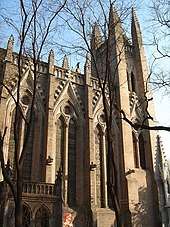
Catholicism
In 1289, John of Montecorvino came to Beijing as a Franciscan missionary with the order from the Pope. After meeting and receiving the support of Kublai Khan in 1293, he built the first Catholic church in Beijing in 1305. The Chinese Patriotic Catholic Association (CPCA), based in Houhai is the government oversight body for Catholics in mainland China. Notable Catholic churches in Beijing include:
- the Nantang or Cathedral of the Immaculate Conception also known as the Xuanwumen Church, which was founded in 1605 and whose current Archbishop Joseph Li Shan is one of the few bishops in China to have the support of both the Vatican and the CPCA.
- the Dongtang or St. Joseph's Church, better known as the Wangfujing Church, founded in 1653.
- the Beitang or Church of the Saviour, also known as the Xishiku Church, founded in 1703.
- the Xitang or Church of Our Lady of Mount Carmel also known as the Xizhimen Church, founded in 1723.
The National Seminary of Catholic Church in China is located in Daxing District.
Protestantism
The earliest Protestant churches in Beijing were founded by British and American missionaries in the second half of the 19th century. Protestant missionaries also opened schools, universities and hospitals which have become important civic institutions. Most of Beijing's Protestant churches were destroyed during the Boxer Rebellion and afterwards rebuilt. In 1958, the 64 Protestant churches in the city are reorganized into four and overseen by the state through the Three-Self Patriotic Movement.
Eastern Orthodox
There was a significant amount of Orthodox Christians in Beijing. Orthodox has come to Beijing along with Russian prisoners from Albazino conflicts in the 17th century.[166] In 1956, Viktor, the bishop of Beijing returned to the Soviet Union, and the Soviet embassy took over the old cathedral and demolished it. In 2007, the Russian embassy built a new church in its garden to serve the Russian Orthodox Christians in Beijing.
Media
Television and radio
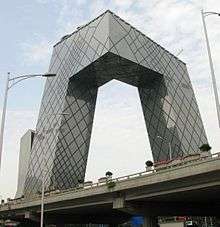
Beijing Television broadcasts on channels 1 through 10, and China Central Television, China's largest television network, maintains its headquarters in Beijing. Three radio stations feature programmes in English: Hit FM on FM 88.7, Easy FM by China Radio International on FM 91.5, and the newly launched Radio 774 on AM 774. Beijing Radio Stations is the family of radio stations serving the city.
Press
The well-known Beijing Evening News, covering news about Beijing in Chinese, is distributed every afternoon. Other newspapers include Beijing Daily, The Beijing News, the Beijing Star Daily (北京娱乐信报), the Beijing Morning News, and the Beijing Youth Daily, as well as English-language weeklies Beijing Weekend and Beijing Today. The People's Daily, Global Times and the China Daily (English) are published in Beijing as well.
Publications primarily aimed at international visitors and the expatriate community include the English-language periodicals Time Out Beijing, City Weekend, Beijing This Month, Beijing Talk, That's Beijing, and The Beijinger.
Sports
Events
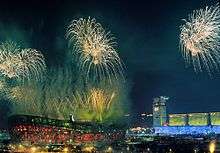
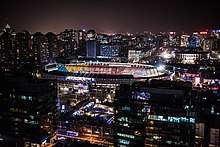
Beijing has hosted numerous international and national sporting events, the most notable was the 2008 Summer Olympic and Paralympic Games. Other multi-sport international events held in Beijing include the 2001 Universiade and the 1990 Asian Games. Single-sport international competitions include the Beijing Marathon (annually since 1981), China Open of Tennis (1993–97, annually since 2004), ISU Grand Prix of Figure Skating Cup of China (2003, 2004, 2005, 2008, 2009 and 2010), WPBSA China Open for Snooker (annually since 2005), Union Cycliste Internationale Tour of Beijing (since 2011), 1961 World Table Tennis Championships, 1987 IBF Badminton World Championships, the 2004 AFC Asian Cup (football), and 2009 Barclays Asia Trophy (football). Beijing hosted the 2015 IAAF World Championships in Athletics.
Beijing's LeSports Center is one of the main venues for the 2019 FIBA Basketball World Cup.[167]
The city hosted the second Chinese National Games in 1914 and the first four National Games of China in 1959, 1965, 1975, 1979, respectively, and co-hosted the 1993 National Games with Sichuan and Qingdao. Beijing also hosted the inaugural National Peasants' Games in 1988 and the sixth National Minority Games in 1999.
In November 2013, Beijing made a bid to host the 2022 Winter Olympics.[168] On 31 July 2015, the International Olympic Committee awarded the 2022 Winter Olympics to the city becoming the first ever to host both Summer and Winter Olympics also for the 2022 Winter Paralympics becoming the first ever to host both Summer and Winter Paralympics.[169]
Venues
Major sporting venues in the city include the National Stadium, also known as the "Birds' Nest",[170][171] National Aquatics Center, also known as the "Water Cube", National Indoor Stadium, all in the Olympic Green to the north of downtown; the MasterCard Center at Wukesong west of downtown; the Workers' Stadium and Workers' Arena in Sanlitun just east of downtown and the Capital Arena in Baishiqiao, northeast of downtown. In addition, many universities in the city have their own sport facilities.
Clubs
Professional sports teams based in Beijing include:
- China Baseball League
- Chinese Basketball Association
- Women's Chinese Basketball Association
- Beijing Shougang
- Kontinental Hockey League
- Chinese Super League
- China League One
- Beijing BG
- China League Two
- Chinese Women's National League
- Beijing BG
The Beijing Olympians of the American Basketball Association, formerly a Chinese Basketball Association team, kept their name and maintained a roster of primarily Chinese players after moving to Maywood, California in 2005.
China Bandy Federation is based in Beijing, one of several cities in which the potential for bandy development is explored.[172]
Transportation
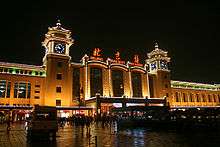
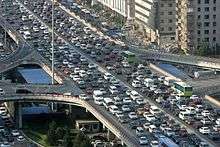
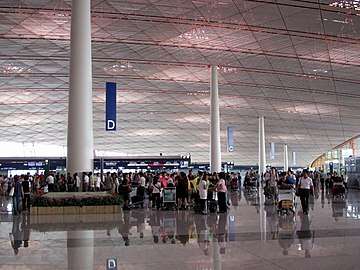
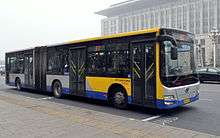
.jpg)
.jpg)
Beijing is an important transport hub in North China with six ring roads, 1167 km of expressways,[173] 15 National Highways, nine conventional railways, and five high-speed railways converging on the city.
Rail and high-speed rail
Beijing serves as a large rail hub in China's railway network. Ten conventional rail lines radiate from the city to: Shanghai (Jinghu Line), Guangzhou (Jingguang Line), Kowloon (Jingjiu Line), Harbin (Jingha Line) (including Qinhuangdao (Jingqin Line)), Baotou (Jingbao Line), Chengde (Jingcheng Line), Tongliao, Inner Mongolia (Jingtong Line), Yuanping, Shanxi (Jingyuan Line) and Shacheng, Hebei (Fengsha Line). In addition, the Datong–Qinhuangdao Railway passes through the municipality to the north of the city.
Beijing also has 5 high-speed rail lines: the Beijing-Tianjin Intercity Railway, which opened in 2008; the Beijing-Shanghai High-Speed Railway, which opened in 2011; and the Beijing–Guangzhou High-Speed Railway, which opened in 2012;the Beijing–Xiong'an intercity railway and Beijing–Zhangjiakou intercity railway, which opened in 2019.
The city's main railway stations are the Beijing railway station, which opened in 1959; the Beijing West railway station, which opened in 1996; and the Beijing South railway station, which was rebuilt into the city's high-speed railway station in 2008; The Beijing North railway station, was first built in 1905 and expanded in 2009; The Qinghe railway station, was first built in 1905 and expanded in 2019;The Fengtai railway station and Xinghuo railway station are under renovation; and the Beijing Sub-Center railway station is under construction. As of 1 July 2010, Beijing railway station had 173 trains arriving daily, Beijing West had 232 trains and Beijing South had 163, and North station had 22 trains.
Smaller stations in the city including Beijing East railway station and Daxing Airport station handle mainly commuter passenger traffic. In outlying suburbs and counties of Beijing, there are over 40 railway stations.[174]
From Beijing, direct passenger train service is available to most large cities in China. International train service is available to Mongolia, Russia, Vietnam and North Korea. Passenger trains in China are numbered according to their direction in relation to Beijing.
Roads and expressways
Beijing is connected by road links to all parts of China as part of the National Trunk Road Network. Many expressways of China serve Beijing, as do 15 China National Highways. Beijing's urban transport is dependent upon the "ring roads" that concentrically surround the city, with the Forbidden City area marked as the geographical center for the ring roads. The ring roads appear more rectangular than ring-shaped. There is no official "1st Ring Road". The 2nd Ring Road is located in the inner city. Ring roads tend to resemble expressways progressively as they extend outwards, with the 5th and 6th Ring Roads being full-standard national expressways, linked to other roads only by interchanges. Expressways to other regions of China are generally accessible from the 3rd Ring Road outward. A final outer orbital, the Capital Area Loop Expressway (G95), was fully opened in 2018 and will extend into neighboring Tianjin and Hebei.
Within the urban core, city streets generally follow the checkerboard pattern of the ancient capital. Many of Beijing's boulevards and streets with "inner" and "outer" are still named in relation to gates in the city wall, though most gates no longer stand. Traffic jams are a major concern. Even outside of rush hour, several roads still remain clogged with traffic.
Beijing's urban design layout further exacerbates transportation problems.[175] The authorities have introduced several bus lanes, which only public buses can use during rush hour. In the beginning of 2010, Beijing had 4 million registered automobiles.[176] By the end of 2010, the government forecast 5 million. In 2010, new car registrations in Beijing averaged 15,500 per week.[177]
Towards the end of 2010, the city government announced a series of drastic measures to tackle traffic jams, including limiting the number of new license plates issued to passenger cars to 20,000 a month and barring cars with non-Beijing plates from entering areas within the Fifth Ring Road during rush hour.[178] More restrictive measures are also reserved during major events or heavily polluted weather.
Road signs began to be standardized with both Chinese and English names displayed, with location names using pinyin, in 2008.[179]
Air
Beijing Capital International Airport
Beijing has two of the world's largest airports. The Beijing Capital International Airport (IATA: PEK) located 32 kilometres (20 mi) northeast of the city center in Chaoyang District bordering Shunyi District, is the second busiest airport in the world after Atlanta's Hartsfield-Jackson International Airport.[18] Capital Airport's Terminal 3, built during the expansion for the 2008 Olympics, is one of the largest in the world. Capital Airport is the main hub for Air China and Hainan Airlines. The Airport Expressway and Second Airport Expressway, connect to Capital Airport from the northeast and east of the city center, respectively. Driving time from city center is about 40 minutes under normal traffic conditions. The Capital Airport Express line of Beijing Subway and the Capital Airport Bus serves the Capital Airport.
Beijing Daxing International Airport
The Beijing Daxing International Airport (IATA: PKX) located 46 kilometres (29 mi) south of the city in Daxing District bordering the city of Langfang, Hebei Province, opened on 25 September 2019.[180][181][182] The Daxing Airport has one of the world's largest terminal buildings and is expected to be a major airport serving Beijing, Tianjin and northern Hebei Province. Daxing Airport is connected to the city via the Beijing–Xiong'an intercity railway, the Daxing Airport Express line of the Beijing Subway and two expressways.
Other airports
With the opening of the Daxing Airport in September 2019, the Beijing Nanyuan Airport (IATA:NAY), located 13 kilometres (8.1 mi) south of center in Fengtai District, has been closed to civilian airline service. Other airports in the city at Liangxiang, Xijiao, Shahe and Badaling are primarily for military use.
Visa requirements for air passengers
As of 1 January 2013, tourists from 45 countries are permitted a 72-hour visa-free stay in Beijing. The 45 countries include Singapore, Japan, the United States, Canada, all EU and EEA countries (except Norway and Liechtenstein), Switzerland, Brazil, Argentina and Australia. The programme benefits transit and business travellers[183] with the 72 hours calculated starting from the moment visitors receive their transit stay permits rather than the time of their plane's arrival. Foreign visitors are not permitted to leave Beijing for other Chinese cities during the 72 hours.[184]
Public transit
The Beijing Subway, which began operating in 1969, now has 23 lines, 404 stations, and 699.3 km (434.5 mi) of lines. It is the longest subway system in the world and first in annual ridership with 3.66 billion rides delivered in 2016. In 2013, with a flat fare of ¥2.00 (0.31 USD) per ride with unlimited transfers on all lines except the Airport Express, the subway was also the most affordable rapid transit system in China. The subway is undergoing rapid expansion and is expected to reach 30 lines, 450 stations, 1,050 kilometres (650 mi) in length by 2022. When fully implemented, 95% of residents inside the Fourth Ring Road will be able to walk to a station in 15 minutes.[185] The Beijing Suburban Railway provides commuter rail service to outlying suburbs of the municipality.
On 28 December 2014, the Beijing Subway switched to a distance-based fare system from a fixed fare for all lines except the Airport Express.[186] Under the new system a trip under 6 km will cost ¥3.00(US$0.49), an additional ¥1.00 will be added for the next 6 kilometres (3.7 miles) and the next 10 kilometres (6.2 miles) until the distance for the trip reaches 32 kilometres (20 miles).[186] For every 20 kilometres (12 miles) after the original 32 kilometres (20 miles) an additional ¥1.00 is added.[186] For example, a 50 kilometres (31 miles) trip would cost ¥ 8.00.
There are nearly 1,000 public bus and trolleybus lines in the city, including four bus rapid transit lines. Standard bus fares are as low as ¥1.00 when purchased with the Yikatong metrocard.
Taxi
Metered taxi in Beijing start at ¥13 for the first 3 kilometres (1.9 mi), ¥2.3 Renminbi per additional 1 kilometre (0.62 mi) and ¥1 per ride fuel surcharge, not counting idling fees which are ¥2.3 (¥4.6 during rush hours of 7–9 am and 5–7 pm) per 5 minutes of standing or running at speeds lower than 12 kilometres per hour (7.5 mph). Most taxis are Hyundai Elantras, Hyundai Sonatas, Peugeots, Citroëns and Volkswagen Jettas. After 15 kilometres (9.3 mi), the base fare increases by 50% (but is only applied to the portion over that distance). Different companies have special colours combinations painted on their vehicles. Usually registered taxis have yellowish brown as basic hue, with another color of Prussian blue, hunter green, white, umber, tyrian purple, rufous, or sea green. Between 11 pm and 5 am, there is also a 20% fee increase. Rides over 15 km (9 mi) and between 23:00 and 06:00 incur both charges, for a total increase of 80%. Tolls during trip should be covered by customers and the costs of trips beyond Beijing city limits should be negotiated with the driver. The cost of unregistered taxis is also subject to negotiation with the driver.
Bicycles
Beijing has long been well known for the number of bicycles on its streets. Although the rise of motor traffic has created a great deal of congestion and bicycle use has declined, bicycles are still an important form of local transportation. Many cyclists can be seen on most roads in the city, and most of the main roads have dedicated bicycle lanes. Beijing is relatively flat, which makes cycling convenient. The rise of electric bicycles and electric scooters, which have similar speeds and use the same cycle lanes, may have brought about a revival in bicycle-speed two-wheeled transport. It is possible to cycle to most parts of the city. Because of the growing traffic congestion, the authorities have indicated more than once that they wish to encourage cycling, but it is not clear whether there is sufficient will to translate that into action on a significant scale.[187] On Mar 30, 2019, a 6.5 km bicycle-dedicated lane was opened, easing the traffic congestion between Huilongguan and Shangdi where there are many high-tech companies.[188] Cycling has seen a resurgence in popularity spurred by the emergence of a large number of dockless app based bikeshares such as Mobike, Bluegogo and Ofo since 2016.[189]
Defense and aerospace
.jpg)
The command headquarters of China's military forces are based in Beijing. The Central Military Commission, the political organ in charge of the military, is housed inside the Ministry of National Defense, located next to the Military Museum of the Chinese People's Revolution in western Beijing. The Second Artillery Corps, which controls the country's strategic missile and nuclear weapons, has its command in Qinghe, Haidian District. The headquarters of the Central Theater Command, one of five nationally, is based further west in Gaojing. The CTR oversees the Beijing Capital Garrison as well as the 27th, 38th and 65th Armies, which are based in Hebei.
Military institutions in Beijing also include academies and thinktanks such as the PLA National Defence University and Academy of Military Science, military hospitals such as the 301, 307 and the Academy of Military Medical Sciences, and army-affiliated cultural entities such as 1 August Film Studios and the PLA Song and Dance Troupe.
The China National Space Administration, which oversees country's space program, and several space-related state owned companies such as CASTC and CASIC are all based in Beijing. The Beijing Aerospace Command and Control Center, in Haidian District tracks the country's manned and unmanned flight and other space exploration initiatives.
Nature and wildlife
Beijing Municipality has 20 nature reserves that have a total area of 1,339.7 km2 (517.3 sq mi).[190] The mountains to the west and north of the city are home to a number of protected wildlife species including leopard, leopard cat, wolf, red fox, wild boar, masked palm civet, raccoon dog, hog badger, Siberian weasel, Amur hedgehog, roe deer, and mandarin rat snake.[191][192][193] The Beijing Aquatic Wildlife Rescue and Conservation Center protects the Chinese giant salamander, Amur stickleback and mandarin duck on the Huaijiu and Huaisha Rivers in Huairou District.[194] The Beijing Milu Park south of the city is home to one of the largest herds of Père David's deer, now extinct in the wild. The Beijing barbastelle, a species of vesper bat discovered in caves of Fangshan District in 2001 and identified as a distinct species in 2007, is endemic to Beijing. The mountains of Fangshan are also habitat for the more common Beijing mouse-eared bat, large myotis, greater horseshoe bat and Rickett's big-footed bat.[195]
Each year, Beijing hosts 200–300 species of migratory birds including the common crane, black-headed gull, swan, mallard, common cuckoo and the endangered yellow-breasted bunting.[196][197] In May 2016, Common cuckoos nesting in the wetlands of Cuihu (Haidian), Hanshiqiao (Shunyi), Yeyahu (Yanqing) were tagged and have been traced to far as India, Kenya and Mozambique.[198][199] In the fall of 2016, the Beijing Forest Police undertook a month-long campaign to crack down on illegal hunting and trapping of migratory birds for sale in local bird markets.[197] Over 1,000 rescued birds of protected species including streptopelia, Eurasian siskin, crested myna, coal tit and great tit were handed to the Beijing Wildlife Protection and Rescue Center for repatriation to the wild.[197][200]
The city flowers are the Chinese rose and chrysanthemum.[201] The city trees are the Chinese arborvitae, an evergreen in the cypress family and the pagoda tree, also called the Chinese scholar tree, a deciduous tree of the family Fabaceae.[201] The oldest scholar tree in the city was planted in what is now Beihai Park during the Tang dynasty,.[202]
See also
- 2045 Peking – the name of an asteroid
- Beijing city fortifications
- Historical capitals of China
- Large Cities Climate Leadership Group
- List of hospitals in Beijing
- List of mayors of Beijing
- List of twin towns and sister cities in China
References
- "Township divisions". ebeijing.gov.cn. Archived from the original on 3 September 2009. Retrieved 22 July 2009.
- "Doing Business in China – Survey". Ministry Of Commerce – People's Republic Of China. Archived from the original on 26 May 2014. Retrieved 5 August 2013.
- Cox, W. (2018). Demographia World Urban Areas. 14th Annual Edition (PDF). St. Louis: Demographia. p. 22. Archived (PDF) from the original on 3 May 2018. Retrieved 15 June 2018.
- "Beijing Municipal Bureau of Statistics and NBS Survey Office in Beijing". Beijing Municipal Bureau of Statistics. 23 January 2019. Archived from the original on 23 January 2019. Retrieved 24 January 2019.
- Cox, W. (2018). Demographia World Urban Areas. 14th Annual Edition (PDF). St. Louis: Demographia. p. 22. Archived (PDF) from the original on 3 May 2018. Retrieved 15 June 2018.
- OECD Urban Policy Reviews: China 2015, OECD READ edition. OECD iLibrary. OECD Urban Policy Reviews. OECD. 2015. p. 37. doi:10.1787/9789264230040-en. ISBN 978-92-64-23003-3. ISSN 2306-9341. Archived from the original on 27 March 2017. Retrieved 8 December 2017.Linked from the OECD here Archived 9 December 2017 at the Wayback Machine
- GDP-2019 is a preliminary data, and GDP-2018 is a revision based on the 2018 CASEN: "Home - Regional - Quarterly by Province" (Press release). China NBS. 15 April 2020. Retrieved 15 April 2020.
- "Subnational Human Development Index". Global Data Lab China. 2020. Retrieved 9 April 2020.
- Loaned earlier via French "Pékin".
- "Beijing". Merriam-Webster.com. Merriam-Webster, Incorporated. Archived from the original on 29 August 2017. Retrieved 29 August 2017.
- Wells, John (3 April 2008). Longman Pronunciation Dictionary (3rd ed.). Pearson Longman. ISBN 978-1-4058-8118-0.
- China Postal Album: Showing the Postal Establishments and Postal Routes in Each Province, 1st ed., Shanghai: Directorate General of Posts, 1907
- Figures based on 2006 statistics published in 2007 National Statistical Yearbook of China and available online at 2006年中国乡村人口数 中国人口与发展研究中心 (archive). Retrieved 21 April 2009.
- "Basic Information". Beijing Municipal Bureau of Statistics. Archived from the original on 13 March 2012. Retrieved 9 February 2008.
- "Beijing". The Columbia Encyclopedia (6th ed.). 2008. Archived from the original on 12 February 2010. Retrieved 22 July 2009.
- "Top 100 Banks in the World". www.relbanks.com. Archived from the original on 29 July 2018. Retrieved 12 September 2018.
- "Beijing has most Fortune 500 global HQs". Beijing Municipal Government. Archived from the original on 28 November 2016. Retrieved 27 November 2016.
- "Year to date Passenger Traffic". Airports Council International. 23 June 2014. Archived from the original on 29 January 2017. Retrieved 26 June 2014.
- "Peking (Beijing)". Encyclopædia Britannica. 25 (15th edition, Macropædia ed.). p. 468.
- "Top Ten Cities Through History". things made unthinkable. Archived from the original on 4 January 2013. Retrieved 28 November 2016.
- "Beijing". Encyclopædia Britannica. Encyclopædia Britannica Online. Archived from the original on 22 June 2008. Retrieved 3 August 2008.
- "Beijing". World Book Encyclopedia. 2008. Archived from the original on 19 May 2008. Retrieved 7 August 2008.
- 走进北京七大世界文化遗产 – 千龙网. qianlong.com (in Chinese). 18 August 2014. Archived from the original on 29 November 2014. Retrieved 21 November 2014.
- 2015年北京市高校名单(共91所). gaokao.com. 22 May 2015. Archived from the original on 30 November 2016. Retrieved 29 November 2016.
- Hucker, Charles O. (1958). "Governmental Organization of the Ming Dynasty". Harvard Journal of Asiatic Studies. 21: 1–66. doi:10.2307/2718619. JSTOR 2718619.
- Lane Harris (2008). "A 'Lasting Boon to All': A Note on the Postal Romanization of Place Names, 1896–1949". Twentieth Century China. 34 (1): 96–109. doi:10.1353/tcc.0.0007.
- Baxter, Wm. H. & Sagart, Laurent. "Baxter–Sagart Old Chinese Reconstruction". Archived from the original on 27 September 2013. (1.93 MB), p. 63. 2011. Retrieved 11 October 2011.
- Coblin, W. South. "A Brief History of Mandarin". Journal of the American Oriental Society 120, no. 4 (2000): 537–552.
- Standardization Administration of China (SAC). "GB/T-2260: Codes for the administrative divisions of the People's Republic of China Archived 5 March 2004 at the Wayback Machine."
- "The Peking Man World Heritage Site at Zhoukoudian". Archived from the original on 9 March 2013. Retrieved 7 April 2008.
- "Beijing's History". China Internet Information Center. Archived from the original on 1 May 2008. Retrieved 1 May 2008.
- Haw, Stephen. Beijing: A Concise History. Routledge, 2007. p. 136.
- Grousset, Rene (1970). The Empire of the Steppes. Rutgers University Press. p. 58. ISBN 978-0-8135-1304-1.
- "Beijing – Historical Background". The Economist. 2007. Archived from the original on 22 May 2007.
- Brian Hook, Beijing and Tianjin: Towards a Millennial Megalopolis, p. 2
- 元大都土城遗址公园. Tuniu.com (in Chinese). Archived from the original on 5 February 2009. Retrieved 15 June 2008.
- Ebrey, Patricia Buckley. The Cambridge Illustrated History of China. Cambridge: Cambridge University Press, 1999. ISBN 0-521-66991-X
- Li, Dray-Novey & Kong 2007, p. 23
- "An Illustrated Survey of Dikes and Dams in Jianghan Region". World Digital Library. Archived from the original on 10 February 2013. Retrieved 9 May 2013.
- "The Temple of Heaven". China.org. 13 April 2001. Archived from the original on 20 June 2008. Retrieved 14 June 2008.
- Robert Hymes (2000). John Stewart Bowman (ed.). Columbia Chronologies of Asian History and Culture. Columbia University Press. p. 42. ISBN 978-0-231-11004-4.
- "Renewal of Ming Dynasty City Wall". Beijing This Month. 1 February 2003. Archived from the original on 3 May 2005. Retrieved 14 June 2008.
- Rosenburg, Matt T. "Largest Cities Through History". About.com. Archived from the original on 27 May 2005. Retrieved 22 July 2009.
- Li, Dray-Novey & Kong 2007, p. 33
- "Beijing – History – The Ming and Qing Dynasties". Britannica Online Encyclopedia. 2008. Archived from the original on 12 May 2008. Retrieved 16 June 2008.
- Elliott 2001, p. 98
- Li, Dray-Novey & Kong 2007, pp. 119–120
- Preston, p. 310–311
- Preston, pp. 312–315
- Li, Dray-Novey & Kong 2007, pp. 133–134
- MacKerras & Yorke 1991, p. 8
- "Incident on 7 July 1937". Xinhua News Agency. 27 June 2005. Archived from the original on 16 December 2008. Retrieved 20 June 2008.
- Li, Dray-Novey & Kong 2007, p. 166
- Cheung, Andrew (1995). "Slogans, Symbols, and Legitimacy: The Case of Wang Jingwei's Nanjing Regime". Indiana University. Archived from the original on 23 October 2007. Retrieved 20 June 2008.
- Li, Dray-Novey & Kong 2007, p. 168
- 毛主席八次接见红卫兵的组织工作. 中国共产党新闻网 (in Chinese). 7 April 2011. Archived 6 July 2017 at the Wayback Machine
- Li, Dray-Novey & Kong 2007, p. 217
- Li, Dray-Novey & Kong 2007, p. 255
- Li, Dray-Novey & Kong 2007, p. 252
- Li, Dray-Novey & Kong 2007, p. 149
- Li, Dray-Novey & Kong 2007, pp. 249–250
- Li, Dray-Novey & Kong 2007, pp. 255–256
- Picture Power:Tiananmen Standoff Archived 17 February 2009 at the Wayback Machine BBC News.
- "IOC: Beijing To Host 2022 Winter Olympics". The Huffington Post. Associated Press. 31 July 2015. Archived from the original on 10 August 2015. Retrieved 11 August 2015.
- Business Buide to Beijing and North-East China (2006–2007 ed.). Hong Kong: China Briefing Media. 2006. p. 108. ISBN 978-988-98673-3-1. Retrieved 22 July 2009.
- Shen, Wei (16 February 2004). "Chorography to record rise and fall of Beijing's Hutongs". China Daily. Archived from the original on 8 March 2008. Retrieved 27 June 2008.
- Amy Stone (Spring 2008). "Farewell to the Hutongs: Urban Development in Beijing". Dissent magazine. Archived from the original on 19 May 2011. Retrieved 14 July 2011.
- Li, Dray-Novey & Kong 2007, p. 253
- Gallagher, Sean (6 December 2006). "Beijing's urban makeover: the 'hutong' destruction". Open Democracy. Archived from the original on 25 May 2008. Retrieved 27 June 2008.
- "Beijing". People's Daily. March 2001. Archived from the original on 18 May 2008. Retrieved 22 June 2008.
- "Archived copy". Archived from the original on 18 March 2013. Retrieved 18 February 2013.CS1 maint: archived copy as title (link)
- "Extreme Temperatures Around the World". Retrieved 21 February 2013.
- 中国地面国际交换站气候标准值月值数据集(1971-2000年) (in Chinese). China Meteorological Administration. Retrieved 4 May 2010.
- "Beijing". China Meteorological Data Sharing Service System. December 2013. Retrieved 1 January 2014.
- Burt, Christopher C. "UPDATE June 1: Record May Heat Wave in Northeast China, Koreas". Wunderground. Retrieved 1 June 2014.
- d.o.o, Yu Media Group. "Beijing, China - Detailed climate information and monthly weather forecast". Weather Atlas. Retrieved 9 July 2019.
- J.R. McNeill, Something New Under the Sun: An Environmental History of the 20th-Century World. New York: Norton, 2000, ISBN 978-0-14-029509-2.
- Mark Z. Jacobson, Son V. Nghiem, Alessandro Sorichetta, Natasha Whitney, Ring of impact from the mega-urbanization of Beijing between 2000 and 2009. In: Journal of Geophysical Research: Atmospheres 120, Issue 12, (2015), 5740–5756, doi:10.1002/2014JD023008.
- Peter Sheehan, Enjiang Cheng, Alex English, Fanghong Sun, China's response to the air pollution shock. In: Nature Climate Change 4, (2014), 306–309, doi:10.1038/nclimate2197.
- David G. Streetsa, Joshua S. Fub, Carey J. Jangc, Jiming Haod, Kebin Hed, Xiaoyan Tange, Yuanhang Zhange, Zifa Wangf, Zuopan Lib, Qiang Zhanga, Litao Wangd, Binyu Wangc, Carolyne Yua, Air quality during the 2008 Beijing Olympic Games accessed 23 April 2012
- "Green Olympics Effort Draws UN Environment Chief to Beijing". Sundance Channel. Archived from the original on 20 March 2012.
- "Beijing petrol stations to close". BBC News. 15 February 2008. Archived from the original on 18 February 2008. Retrieved 15 February 2008.
- Yardley, Jim (24 January 2008). "Smoggy Beijing Plans to Cut Traffic by Half for Olympics, Paper Says". New York Times. Archived from the original on 17 April 2009. Retrieved 22 July 2009.
- "Post-Olympics Beijing car restrictions to take effect next month". News.xinhuanet.com. 28 September 2008. Archived from the original on 16 December 2008. Retrieved 1 June 2010.
- "Only 'green' vehicles permitted to enter Beijing". Autonews.gasgoo.com. 22 May 2009. Archived from the original on 27 May 2009. Retrieved 1 June 2010.
- "China: Beijing launches Euro 4 standards". Automotiveworld.com. 4 January 2008. Archived from the original on 27 April 2010. Retrieved 1 June 2010.
- James West, Mother Jones Archived 29 April 2017 at the Wayback Machine. 18 January 2013.
- "Beijing to switch from coal to gas to go green". China Daily Archived 5 December 2013 at the Wayback Machine. 8 March 2012.
- Li Jing, "Beijing's air quality will worsen without coal control, Greenpeace says". South China Morning Post. 5 February 2013 Archived 15 November 2013 at the Wayback Machine.
- "Detecting the Heavy Metal Concentration of PM2.5 in Beijing", Greenpeace.org. 8 June 2013.
- Chang, Lyu (24 March 2015). "Beijing shuts two more coal-fired power plants". The China Daily. Archived from the original on 30 June 2016. Retrieved 31 May 2016.
- Stanway, David (23 July 2014). "Beijing shuts big coal-fired power plant to ease smog –Xinhua". Reuters. Archived from the original on 30 June 2016. Retrieved 31 May 2016.
- Demick, Barbara (2 October 2009). "Communist China celebrates 60th anniversary with instruments of war and words of peace". Los Angeles Times. Archived from the original on 14 October 2009. Retrieved 11 October 2009.
- Liu, Charles (12 May 2016). ""Parade Blue" Joins "APEC Blue" as Distant Memories as Nasty Air Returns to Beijing". The Nanfang. Archived from the original on 28 November 2016. Retrieved 28 November 2016.
- Wong, Edward (12 January 2013). "Beijing Air Pollution Off the Charts". The New York Times. Archived from the original on 3 March 2017. Retrieved 21 February 2017.
- Wong, Edward (9 December 2015). "As Beijing Shuts Down Over Smog Alert, Worse-Off Neighbors Carry On". The New York Times. ISSN 0362-4331. Archived from the original on 9 December 2015. Retrieved 9 December 2015.
- "Beijing issues second red alert for choking smog". ABC News. ABC. 18 December 2015. Archived from the original on 18 December 2015. Retrieved 18 December 2015.
- Reuters (22 November 2016). "Beijing to ban polluting cars during smog alerts". www.atimes.com. Archived from the original on 2 December 2016. Retrieved 2 December 2016.
- Greenstone, Michael (12 March 2018). "Four Years After Declaring War on Pollution, China Is Winning". The New York Times. ISSN 0362-4331. Archived from the original on 11 January 2019. Retrieved 15 January 2019.
- 首页. Beijing Municipal Web. Archived from the original on 29 December 2015.
- Barbara Demick (29 October 2011). "U.S. Embassy air quality data undercut China's own assessment". Los Angeles Times. Archived from the original on 7 November 2011. Retrieved 7 November 2011. (login required)
- Zhao, Xiaoli; Yu, Xueying; Wang, Ying; Fan, Chunyang (1 June 2016). "Economic evaluation of health losses from air pollution in Beijing, China". Environmental Science and Pollution Research. 23 (12): 11716–11728. doi:10.1007/s11356-016-6270-8. ISSN 0944-1344. PMID 26944425.
- Maji, Kamal Jyoti; Arora, Mohit; Dikshit, Anil Kumar (1 April 2017). "Burden of disease attributed to ambient PM2.5 and PM10 exposure in 190 cities in China". Environmental Science and Pollution Research. 24 (12): 11559–11572. doi:10.1007/s11356-017-8575-7. ISSN 0944-1344. PMID 28321701.
- "China says it made rain to wash off sand". NBC News. 5 May 2006. Retrieved 22 July 2009.
- "Beijing hit by eighth sandstorm". BBC News. 17 April 2006. Archived from the original on 30 September 2009. Retrieved 22 July 2009.
- Weaver, Lisa Rose (4 April 2002). "More than a dust storm in a Chinese teacup". CNN. Archived from the original on 13 January 2007. Retrieved 7 February 2008.
- "Beijing – Administration and society – Government". Britannica Online Encyclopedia. 2008. Archived from the original on 9 June 2008. Retrieved 16 June 2008.
- 国家统计局统计用区划代码. National Bureau of Statistics of the People's Republic of China. Archived 5 April 2013 at the Wayback Machine
- 2017年度北京市土地利用现状汇总表. ghgtw.beijing.gov.cn. Archived from the original on 13 January 2019. Retrieved 13 January 2019.
- Census Office of the State Council of the People's Republic of China; Population and Employment Statistics Division of the National Bureau of Statistics of the People's Republic of China (2012). 中国2010年人口普查分乡、镇、街道资料 (1 ed.). Beijing: China Statistics Print. ISBN 978-7-5037-6660-2.
- 国务院人口普查办公室、国家统计局人口和社会科技统计司编 (2012). 中国2010年人口普查分县资料. Beijing: China Statistics Print. ISBN 978-7-5037-6659-6.
- 《中国民政统计年鉴2012》
- 北京市第三中级人民法院、北京市人民检察院第三分院同日成立. Xinhua (in Chinese). 6 August 2013. Archived 29 September 2013 at the Wayback Machine
- 北京市高级人民法院关于我市中级人民法院管辖调整有关问题的规定(暂行). chinacourt.org (in Chinese). 2 August 2013. Archived 14 August 2013 at the Wayback Machine
- Historical GDP of Beijing published on Beijing Statistical Yearbook 2017, ALSO see Beijing'GDP Revison (Chinese) Archived 13 December 2017 at the Wayback Machine (10 October 2017)
- "Jones Lang LaSalle Research Report – Five years after the Olympics – Growth in Beijing has continued, what to expect next?" Archived 18 May 2014 at the Wayback Machine August 2013
- Shapiro, Ariel R. "Beijing is 'Billionaire Capital of the World'". Archived from the original on 9 July 2018. Retrieved 19 July 2018.
- "Beijing is new 'billionaire capital'". BBC News. 25 February 2016. Archived from the original on 19 July 2018. Retrieved 19 July 2018.
- Purchasing power parity (PPP) for Chinese yuan is estimate according to IMF WEO (October 2017 Archived 14 February 2006 at Archive-It) data; Exchange rate of CN¥ to US$ is according to State Administration of Foreign Exchange, published on China Statistical Yearbook Archived 20 October 2015 at the Wayback Machine.
- NBS Beijing investigatory team (国家统计局北京调查总队) (13 February 2014). 北京市2013年国民经济和社会发展统计公报 (in Chinese). Beijing Bureau of Statistics.
- 北京五年淘汰140余家"三高"企业. 北京商报 (in Chinese). 17 November 2010. Archived 29 November 2014 at the Wayback Machine
- "Capital Steel opens new branch to step up eastward relocation". People's Daily Online. 23 October 2005. Archived from the original on 16 December 2008. Retrieved 24 October 2008.
- Spencer, Richard (18 July 2008). "Beijing abandons Mao's dream of workers' paradise". The Daily Telegraph. London. Archived from the original on 19 August 2008. Retrieved 25 April 2019.
- 六大功能区 (in Chinese). Archived 14 September 2013 at the Wayback Machine
- Tu, Lufang (涂露芳) (9 October 2013). 六大功能区创造北京四成多GDP. Beijing Daily. Archived 14 October 2013 at the Wayback Machine
- 北京市统计局 六大高端产业功能区主要经济指标 (in Chinese). Beijing Bureau of Statistics. 12 August 2014. Archived 29 November 2014 at the Wayback Machine
- "ShiJingShan". Beijing Economic Information Center. Archived from the original on 20 November 2008. Retrieved 22 June 2008.
- "Pirates weave tangled web on 'Spidey'". The Hollywood Reporter. Reuters. 27 April 2007. Archived from the original on 29 April 2007. Retrieved 15 March 2008.
- 北京市2014年国民经济和社会发展统计公报 [Beijing Economic and Social Development Statistical Bulletin 2014] (in Chinese). Beijing Bureau of Statistics. 12 February 2015. Archived from the original on 1 March 2016. Retrieved 1 May 2015.
- CNBC.com, Justina Crabtree; special to (20 September 2016). "A tale of megacities: China's largest metropolises". CNBC. Archived from the original on 9 December 2017. Retrieved 8 December 2017.
slide 4
- "Age Composition and Dependency Ratio of Population by Region (2004) in China Statistics 2005". Archived from the original on 4 December 2010. Retrieved 5 July 2010.
- 北京市2010年第六次全国人口普查主要数据情况. Beijing Bureau of Statistics.
- 北京市少数民族人口状况 (in Chinese). Beijing Bureau of Statistics. 30 May 2011.
- 在北京外国人数量或已达20万人 超过市人口总数1%. 中国新闻网 (in Chinese). 9 October 2010. Archived 29 November 2014 at the Wayback Machine
- Roxburgh, Helen (19 March 2018). "China's radical plan to limit the populations of Beijing and Shanghai". the Guardian. Archived from the original on 9 April 2018. Retrieved 16 August 2018.
- China to move half a million people from Beijing to new city
- A plan to build a city from scratch that will dwarf New York
- "Jingxi". Britannica Online Encyclopedia. 2008. Archived from the original on 3 May 2008. Retrieved 16 June 2008.
- "Beijing – Chinese Cloisonné Enamelware". Archived from the original on 11 June 2008.
- Levin, Dan (15 June 2008). "Beijing Lights Up the Night". The New York Times. Archived from the original on 17 April 2009. Retrieved 15 June 2008.
- "Beijing, Jeonju, and Norwich named UNESCO Creative Cities | ASEF culture360". culture360.asef.org. Archived from the original on 4 October 2018. Retrieved 3 October 2018.
- "Beijing, Places of a Lifetime". National Geographic Society. Archived from the original on 3 August 2008. Retrieved 3 August 2008.
- "The Imperial Palace of the Ming and Qing Dynasties" (PDF). UNESCO World Heritage Center. 29 December 1986. Archived (PDF) from the original on 26 March 2009. Retrieved 22 July 2009.
- "Beihai Park Behind Behai park locates Hou Hai, which is one of the most popular visited tourist places. Hou hai is the largest of the three lakes, along with Qianhai (lit. the "Front Lake") and Xihai (lit. the "Western Lake"), that comprise Shichahai, the collective name for the three northern-most lakes in central Beijing. Since the early 2000s, the hutong neighborhood around Houhai has become known for its nightlife as many residences along the lake shore have been converted into restaurants, bars, and cafes". UNECO World Heritage. Archived from the original on 2 July 2007.
- Littlewood, Misty and Mark Littlewood (2008). Gateways to Beijing: a travel guide to Beijing. Armour Publishing Pte Ltd. p. 182. ISBN 978-981-4222-12-9.
- "Summer Palace, an Imperial Garden in Beijing". UNESCO World Heritage Center. Archived from the original on 24 July 2008. Retrieved 4 August 2008.
- "Temple of Heaven: an Imperial Sacrificial Altar in Beijing". UNESCO World Heritage Center. Archived from the original on 1 August 2008. Retrieved 4 August 2008.
- (Chinese) [北京地区博物馆名录(截止2008年6月)] 6 January 2009
- "About Beijing". Archived from the original on 29 September 2008.
- "Beijing's Museums & Galleries". Archived from the original on 13 August 2008. Retrieved 19 August 2008.
- "Imperial Tombs of the Ming and Qing Dynasties". UNESCO World Heritage Center. 10 December 2003. Archived from the original on 2 August 2009. Retrieved 22 July 2009.
- "Peking Man Site at Zhoukoudian". UNESCO World Heritage Center. Archived from the original on 23 July 2008. Retrieved 4 August 2008.
- "The Great Wall". UNESCO World Heritage Center. Archived from the original on 31 July 2008. Retrieved 4 August 2008.
- 北京的宗教文化. 中国网 (in Chinese). 11 July 2008. Archived 16 April 2017 at the Wayback Machine
- Lai, Hongyi. China's Governance Model: Flexibility and Durability of Pragmatic Authoritarianism. Routledge, 2016. ISBN 1-317-85952-9. p. 167
- China General Social Survey (CGSS) 2009. Report by: Xiuhua Wang (2015, p. 15) Archived 25 September 2015 at the Wayback Machine
- Min Junqing. The Present Situation and Characteristics of Contemporary Islam in China. JISMOR, 8. 2010 Islam by province, p. 29 Archived 27 April 2017 at the Wayback Machine. Data from: Yang Zongde, Study on Current Muslim Population in China, Jinan Muslim, 2, 2010.
- 平谷轩辕山国际旅游区概念性规划. zsfh.org.Archived 2 February 2017 at the Wayback Machine.
- 2020世界休闲大会战略规划 – 北京平谷旅游发展重大项目储备规划. fanhuazhida.com.Archived 21 January 2017 at the Wayback Machine.
- 北京市道教协会协会简介. Beijing Taoist Association. Archived 14 August 2015 at the Wayback Machine
- 伊斯兰教简介 (in Chinese). Beijing Bureau of Ethnic Affairs.Archived 30 January 2017 at the Wayback Machine Accessed 4 April 2016
- 北京市清真寺文物等级 (in Chinese). Beijing Bureau of Ethnic Affairs. Archived 16 April 2016 at the Wayback Machine Accessed 4 April 2016
- 朝阳文化--文化遗产. 24 September 2015. Archived from the original on 24 September 2015. Retrieved 21 February 2019.
- 北京市部分清真寺介绍 (in Chinese). Beijing Bureau of Ethnic Affairs.Archived 16 April 2016 at the Wayback Machine Accessed 4 April 2016
- Eric Widmer, The Russian Ecclesiastical Mission in Peking During the Eighteenth Century, p. 23, 1976, ISBN 0-674-78129-5 Google Books Archived 6 September 2015 at the Wayback Machine
- The Official website of the 2019 FIBA Basketball World Cup Archived 27 May 2017 at the Wayback Machine, FIBA.com, Retrieved 9 March 2016.
- "Beijing and Zhangjiakou launch joint bid to host 2022 Winter Olympic Games". insidethegames.biz. Archived from the original on 5 November 2013. Retrieved 5 November 2013.
- "IOC awards 2022 Winter Olympics to Beijing". Archived from the original on 15 July 2017. Retrieved 24 August 2017.
- Some 350,000 residents were expected to be relocated to make room for the constructions of stadiums for the 2008 Summer Olympics. Davis, Mike (2006). Planet of Slums. Verso. p. 106. ISBN 978-1-84467-022-2. Retrieved 3 January 2017.
- "Beijing Olympics Bird's Nest ready". BBC News. 28 June 2008. Archived from the original on 19 July 2008. Retrieved 28 June 2008.
- "Welcome". chinabandy.org. Archived from the original on 4 March 2016. Retrieved 10 November 2016.
- Beijing Municipal Bureau of Statistics. "Statistical Communiqué on the National Economy and Social Development of Beijing in 2019". Beijing Stat Bureau.
- 北京市火车站大全. oklx.com. Archived from the original on 30 March 2006. Retrieved 8 August 2011.
- "Beijingers spend lives on road as traffic congestion worsens". China Daily. Xinhua News Agency. 6 October 2003. Archived from the original on 24 July 2009. Retrieved 22 July 2009.
- "Automobile numbers could be capped". China Daily. Archived from the original on 9 November 2010. Retrieved 13 May 2010.
- "Beijing city to have five mln cars on roads by year end". Gasgoo. 12 May 2010. Archived from the original on 2 January 2013. Retrieved 13 May 2010.
- "To Tackle Traffic Jam, Beijing Sets New Car Plate Quota, Limits Out-of-Towners". ChinaAutoWeb.com. Archived from the original on 28 December 2010. Retrieved 13 January 2011.
- "Beijing Standardizes Translations of Road Signs". Shanghai Daily at china.org.cn. 24 March 2006. Archived from the original on 8 February 2011. Retrieved 28 October 2018.
- 北京大兴国际机场正式投运. Xinhua. 25 September 2019. Retrieved 28 October 2019 – via Sina Finance.
- 首都新机场跑道呈三纵一横分布 规划7条跑道. news.carnoc.com. Archived from the original on 5 March 2016. Retrieved 12 January 2016.
- "China plans to build world's biggest airport near Beijing". In.news.yahoo.com. 10 September 2011. Archived from the original on 19 May 2012. Retrieved 31 October 2011.
- "Beijing grants three-day visa-free access". TTGmice. 6 December 2012. Archived from the original on 5 June 2013. Retrieved 7 December 2012.
- "Beijing 72-hour Visa-free" ChinaTour.Net Archived 18 March 2015 at the Wayback Machine Accessed 6 June 2014
- "30 subway lines to cover Beijing by 2020". China Daily. 28 May 2010. Archived from the original on 23 August 2010. Retrieved 30 May 2010.
- "Beijing to Increase Public Transportation Fare Prices Next Month". english.cri.cn. Archived from the original on 22 December 2015. Retrieved 24 December 2015.
- Watts, Jonathan (24 January 2010). "Campaign to boost cycling in Beijing". The Guardian. UK. Archived from the original on 9 September 2013. Retrieved 10 March 2011.
- Xin, Wen (14 August 2019). "Beijing's first dedicated bike lane eases traffic congestion". China Daily. Retrieved 31 May 2020.
- "Ofo, Mobike, BlueGogo: China's Messy Bikeshare Market". What's on Weibo. Archived from the original on 6 August 2017. Retrieved 13 August 2017.
- 北京市自然保护区名录(截至2011年底). Ministry of Environmental Protection of the People's Republic of China. 24 August 2012. Archived from the original on 23 October 2012. Retrieved 6 April 2013.
- 北京一级保护野生动物 (in Chinese). Beijing Wildlife Conservation Association. Archived from the original on 16 April 2013. Retrieved 4 April 2013.
- 北京二级保护野生动物 (in Chinese). Beijing Wildlife Conservation Association. Archived from the original on 26 December 2007. Retrieved 4 April 2013.
- Michael Rank, Wild leopards of Beijing, Danwei.org Archived 2 May 2013 at the Wayback Machine 31 July 2007
- (Chinese) Beijing Aquatic Wildlife Rescue and Conservation Center Accessed 5 April 2013 Archived 23 August 2011 at the Wayback Machine
- 70年解密大足鼠耳蝠吃鱼. sxrb.com (in Chinese). 14 April 2007. Archived from the original on 19 March 2014. Retrieved 19 September 2013.
- 北京:候鸟翱翔野鸭湖 Xinhua (in Chinese). 16 November 2016. Archived from the original on 28 November 2016. Retrieved 27 November 2016.
- 北京开始"清网行动"保护候鸟 森林公安公布举报电话, 北京晚报. qianlong.com (in Chinese). 30 October 2016. Archived from the original on 28 November 2016. Retrieved 27 November 2016.
- Beijing Cuckoo Project Archived 28 November 2016 at the Wayback Machine Accessed 28 November 2016
- "With a Cuckoo's Journey from China, a Mystery is Solved, and Cheers Go Up" N.Y. Times Archived 28 November 2016 at the Wayback Machine 11 November 2016
- "北京集中一个月打击非法捕售鸟 抓获36名违法者" 新京报. The Beijing News. Xinhua News. 31 October 2016. Archived from the original on 9 November 2016. Retrieved 27 November 2016.
- 首都之窗-北京市政务门户网站-市花市树. eBeijing.gov.cn. Archived from the original on 13 April 2013.
- 北京市市树 – 国槐. bjkp.gov.cn. 18 February 2004. Archived from the original on 13 April 2008. Retrieved 19 November 2016.
Further reading
- Cotterell, Arthur. (2007). The Imperial Capitals of China: An Inside View of the Celestial Empire. London: Pimlico. pp. 304 pages. ISBN 978-1-84595-009-5.
- Elliott, Mark C. (2001). The Manchu Way: The Eight Banners and Ethnic Identity in Late Imperial China. Palo Alto, CA: Stanford University Press. ISBN 978-0-8047-4684-7. Retrieved 22 July 2009.CS1 maint: ref=harv (link)
- Li, Lillian; Dray-Novey, Alison; Kong, Haili (2007). Beijing: From Imperial Capital to Olympic City. New York City: Palgrave Macmillan. ISBN 978-1-4039-6473-1.CS1 maint: ref=harv (link)
- Bonino, Michele; De Pieri, Filippo (2015). Beijing Danwei: Industrial Heritage in the Contemporary City. Berlin: Jovis. ISBN 978-3-86859-382-2.
- Cammelli, Stefano Storia di Pechino e di come divenne capitale della Cina, Bologna, Il Mulino, 2004. ISBN 978-88-15-09910-5
- Chen, Gaohua: The Capital of the Yuan Dynasty. [Dadu or Khanbaliq]. Silkroad Press, 2015. ISBN 978-981-4332-44-6, 978-981-4339-55-1 (P{rint & eBook)
- Harper, Damian, Beijing: City Guide, 7th Edition, Oakland, California: Lonely Planet Publications, 2007.
- Harper, Damian, Beijing: City Guide, 6th Edition, Oakland, California : Lonely Planet Publications, 2005. ISBN 1-74059-782-6.
- MacKerras, Colin; Yorke, Amanda (1991). The Cambridge Handbook of Contemporary China. Cambridge: Cambridge University Press. ISBN 978-0-521-38755-2. Retrieved 22 July 2009.
beiping beijing.
CS1 maint: ref=harv (link)
External links
- Economic profile for Beijing at HKTDC
- Visit Beijing Facebook Page
- Photograph of The approach to Peking – outside the walls taken in 1890 by Sir Henry Norman
| Preceded by Lin'an (Song dynasty) |
Capital of China (as Dadu of Yuan) 1264–1368 |
Succeeded by Nanjing (Ming dynasty) |
| Preceded by Nanjing (Ming dynasty) |
Capital of China 1420–1928 |
Succeeded by Nanjing (ROC) |
| Preceded by Nanjing (ROC) |
Capital of the People's Republic of China 1949–present |
Succeeded by present capital |
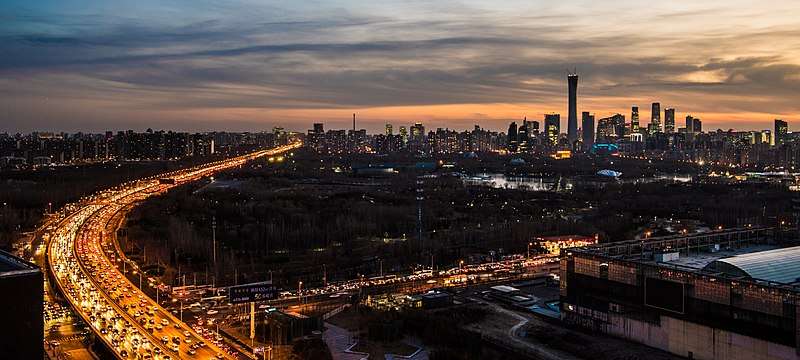
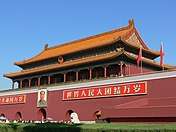
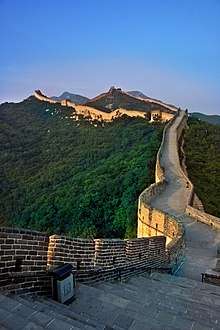
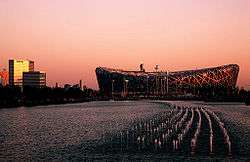


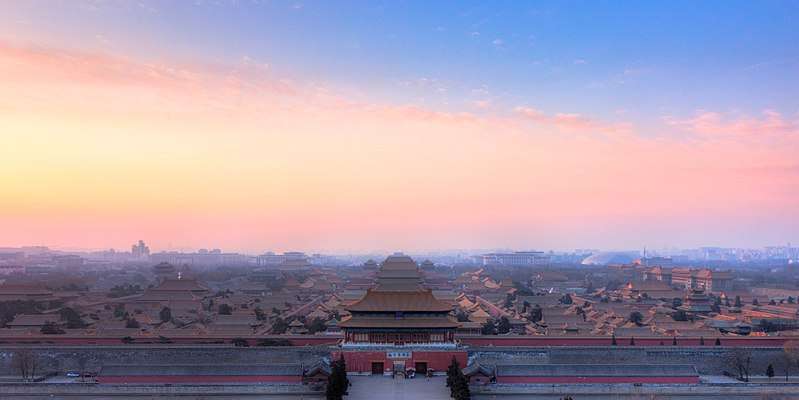
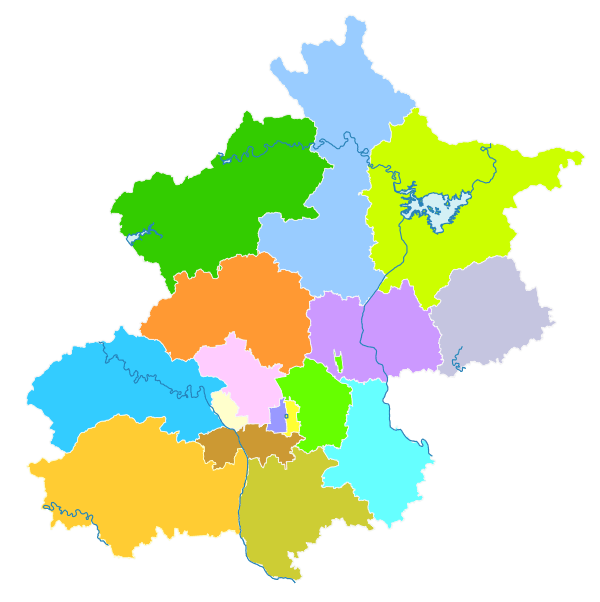

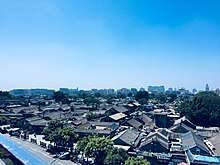
.jpg)
